Disclaimer: This post contains affiliate links to handpicked partners, including tours, gear and booking sites. If you click through or buy something via one of them, I may receive a small commission. This is at no extra cost to you and allows this site to keep running.
It has a distinctive atmosphere that marks it out from other Austrian cities, yet you most probably haven’t heard of it outside of Vienna, Salzburg and Innsbruck. Here’s what to do in Graz to uncover one of Austria’s best-kept secrets, curated after five visits.
As modern and creative as it is old and traditional, Graz is a city of arts and contemporary culture. Its history spans 900 years, from the Middle Ages to the 21st century. Graz emits a strong Mediterranean vibe, making you feel more south of Austria than you are.
It’s found in the preserved UNESCO World Cultural Heritage site with old-world charms and deep-rooted history where Renaissance, Gothic and Baroque structures intertwine. But that’s just one half of its cultural story. The modern persona of Graz, which helped give it the coveted titles of UNESCO City of Design, European Cultural Capital, and Austria’s Culinary Capital, is just as worthy of your attention to understand it as a whole.
While there is a mesh to the old and new parts of Graz, the River Mur neatly cuts the more prominent aspects of old and new Graz in two, which makes for more straightforward navigation for visitors wanting to delve deeper into its two distinct personalities. Locals see this ‘south’ side of the city as more ‘playful’, and the contrast between the two is welcomed and celebrated.
Graz, the second-largest city in Austria and the state capital of Styria is rather proud of its distinction. However, it has always remained off the radar compared to other Austrian cities. If you want to explore a lesser-known destination in Austria, this is your city, and this is how to uncover it all.
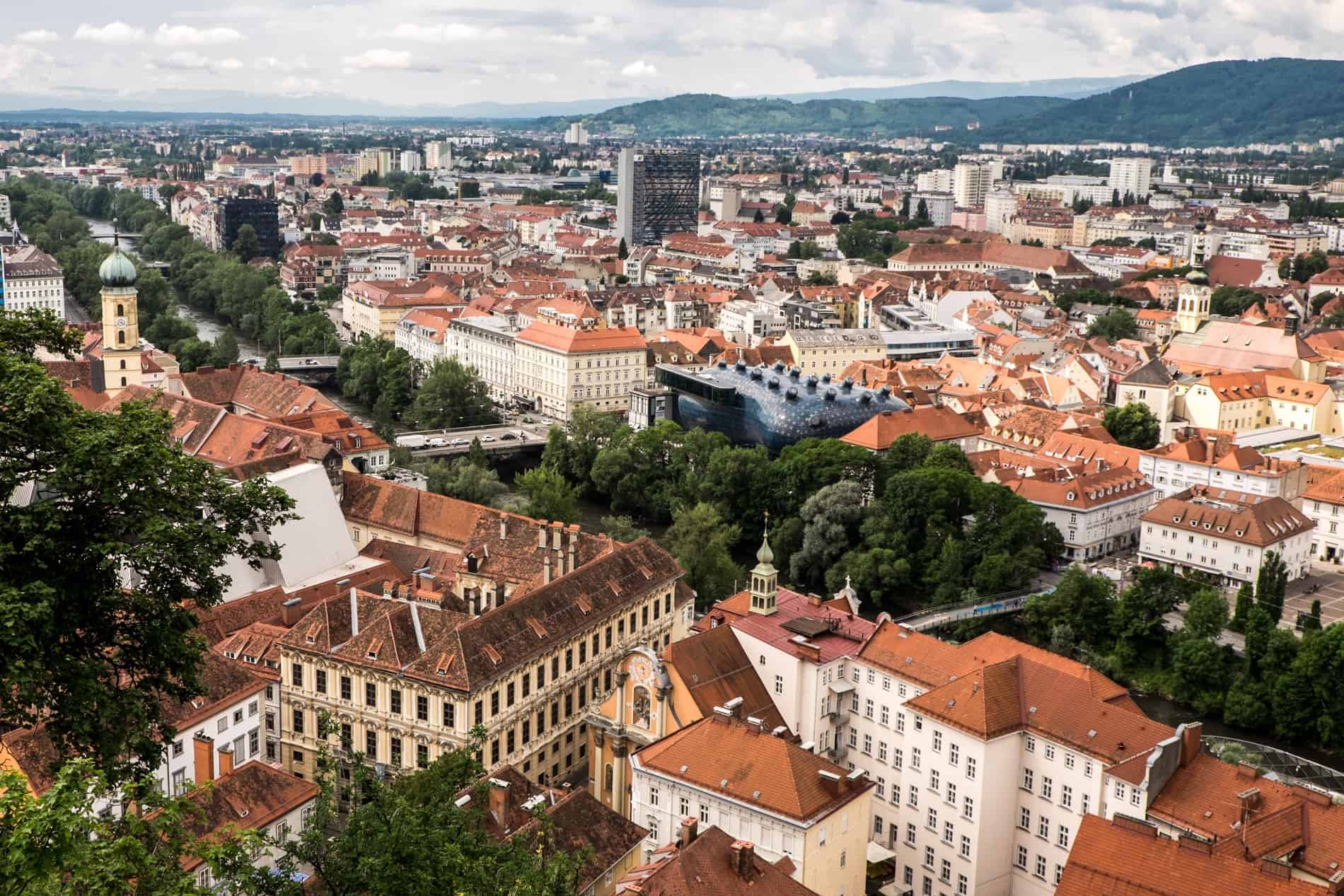
What to Do in Graz – The Mediterranean City of Austria.
Contents
Historic Things to See in Graz
Graz UNESCO World Heritage Historic Centre
The City of Graz Historic Centre, including Schloss Eggenberg on its fringes, is a UNESCO World Heritage Site because of its harmonious blend of architectural styles through the ages. The mix of Renaissance, Gothic and Baroque architecture gave Graz “the best-preserved city centre of Central Europe” title. It’s a city with abundant detail, from the rooftops and delicate balconies to the old establishments that line the pavements and the wall-bound figurine details and frescos.
The compact Historic Centre is easy to navigate, where this integration of varying designs and structures is melded together in a small space by a hill and a park. It is a living history walking tour with green spaces and sweeping viewpoints, and in between, townhouses painted with old murals to romantic courtyards, open baroque squares and winding cobblestoned streets.
Walking amongst the history, you can trace Graz’s story from its early days as an old town with a fortress through to the Imperial years of the late 1400s and beyond and to the modern cultural, art and design foundations that have been added to the mix in recent years.

The best views over Graz are from the Schlossberg.
Graz Historic Centre Attractions
Herrengasse, which is the main thoroughfare of the city, and the adjacent main square, Graz Hauptplatz are at the very heart of the city and central to navigation. Herrengasse is lined with modern stores and bars, yet also with palaces, alleyways to grand squares and preserved historic buildings.
Graz Hauptplatz (Town Square) is marked by a statue of Archduke Johann of Austria (the “Styrian Prince”), who helped develop Graz with various initiatives and grand visions over 50 years. It was the city’s very first marketplace during the medieval era, now dominated by the magnificent 19th century Rathaus, which was built around the houses people refused to sell to make way for it.
Graz buildings of significance include the Painted House at number 7, adorned with Baroque frescos in 1742, the Luegghaus façade on the bottom corner of Sporgasse, now home to the Swarovski store, and the Glockenspielhaus at Glockenspielplatz 4. Catch the performance when the Glockenspiel strikes at 11 am, 3 pm and 6 pm.
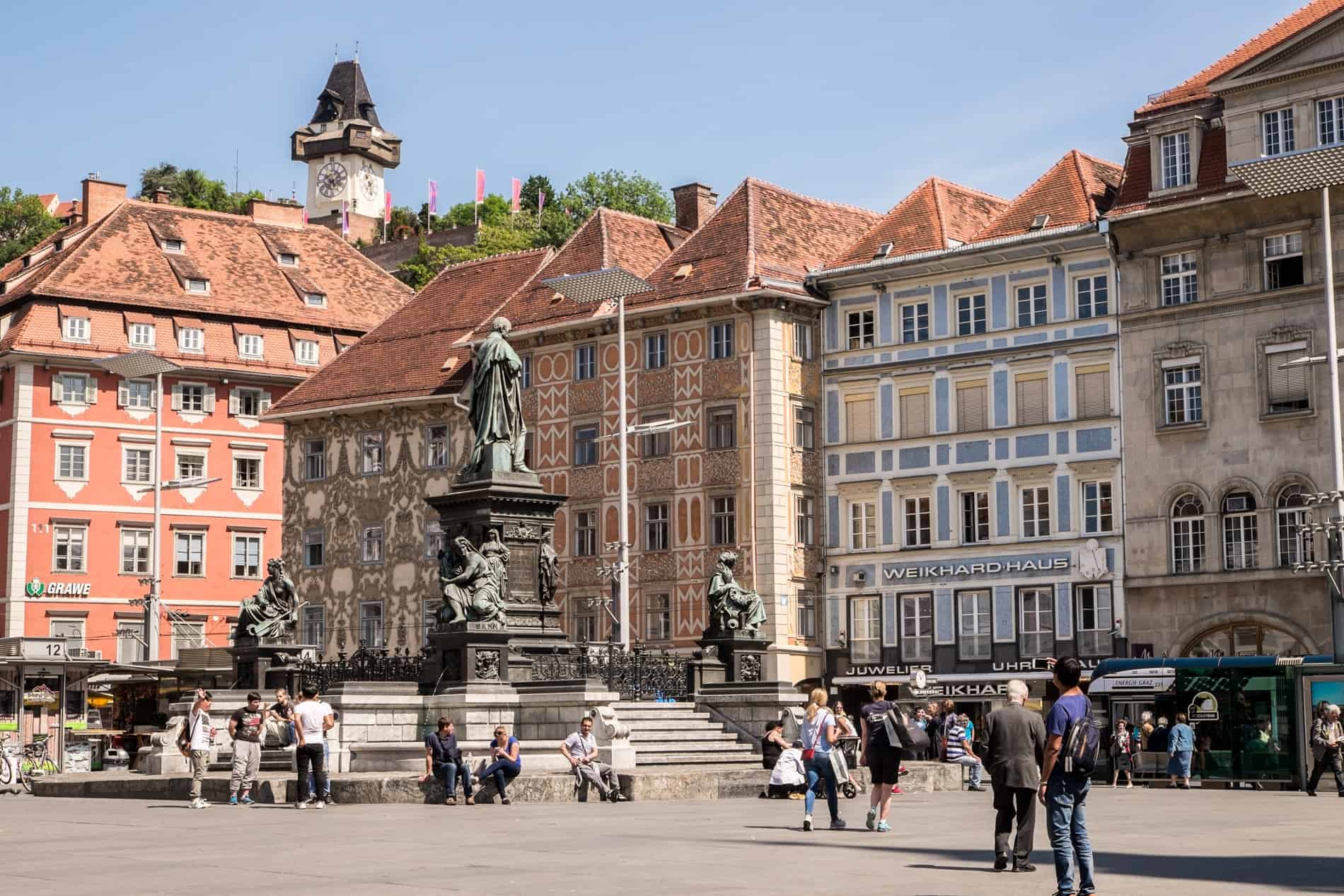
Statues, red roofs and pastel building hues of Graz Hauptplatz.
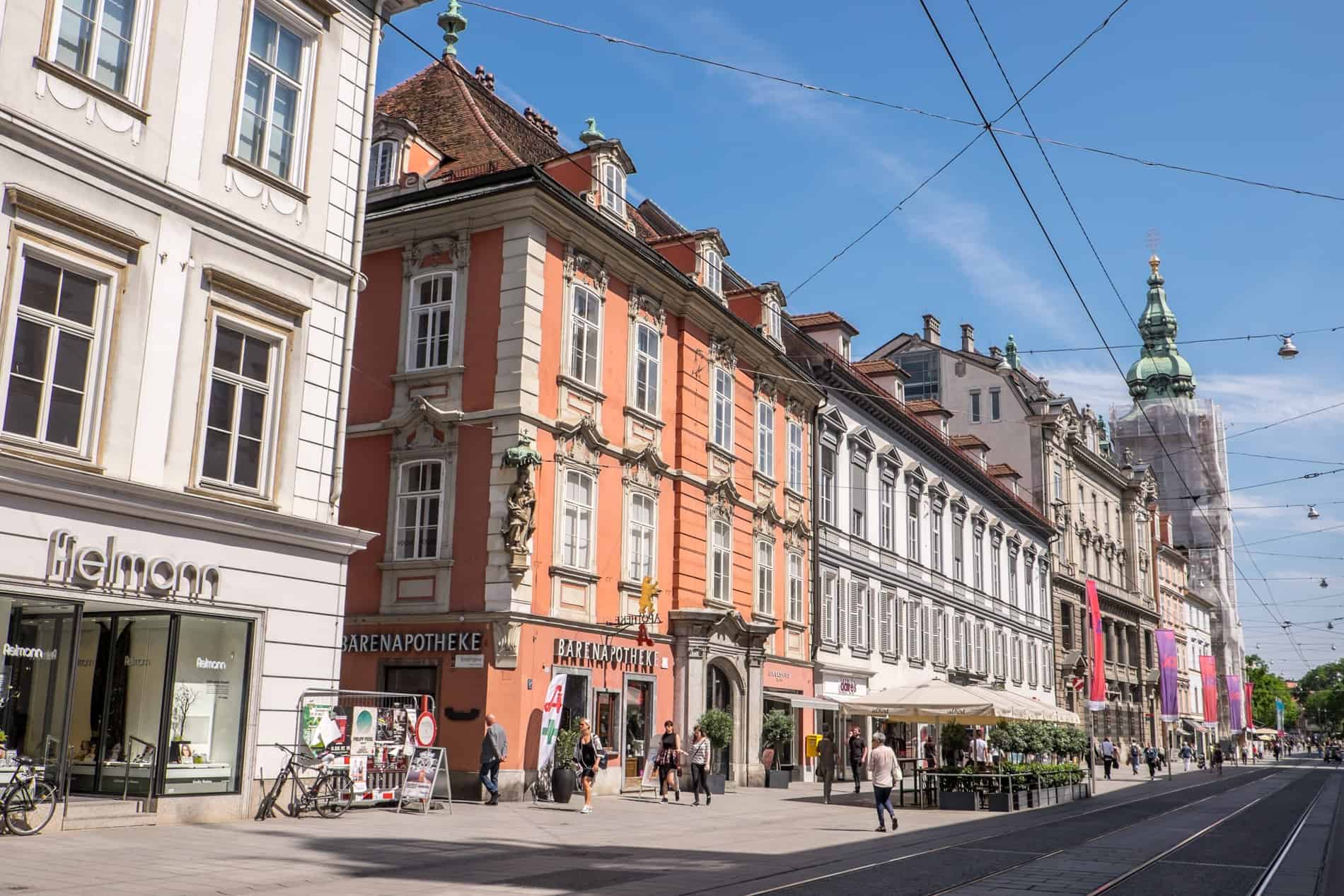
Historic Herrengasse, Graz.
Graz Walking Tours
There is a historic centre walking tour run by Graz Tourist Information, which starts at its location on Herrengasse 16. A Graz tour is one way to have an introduction to the history of the city while viewing the most revered facades, courtyards and romantic squares. Alternatively, pick up a map from the Tourist Office and follow the marked route.
Private walking tours are more expensive, on average €150 for two hours of guidance with a local. This top-rated Graz Old Town Highlights Walking Tour includes visits to Graz Cathedral, skip-the-line tickets to Landeszeughaus (Styrian Armoury), the Graz Museum Schlossberg and Burggarten, alongside architectural and old town sites of significance.
Graz Italian Renaissance Architecture
What you immediately notice about Graz is the centuries-old streets awash with an air of Italian charm that passes from the alfresco dining streets to avenues that lead you to the squares, archways and townhouse facades in earthly shades.
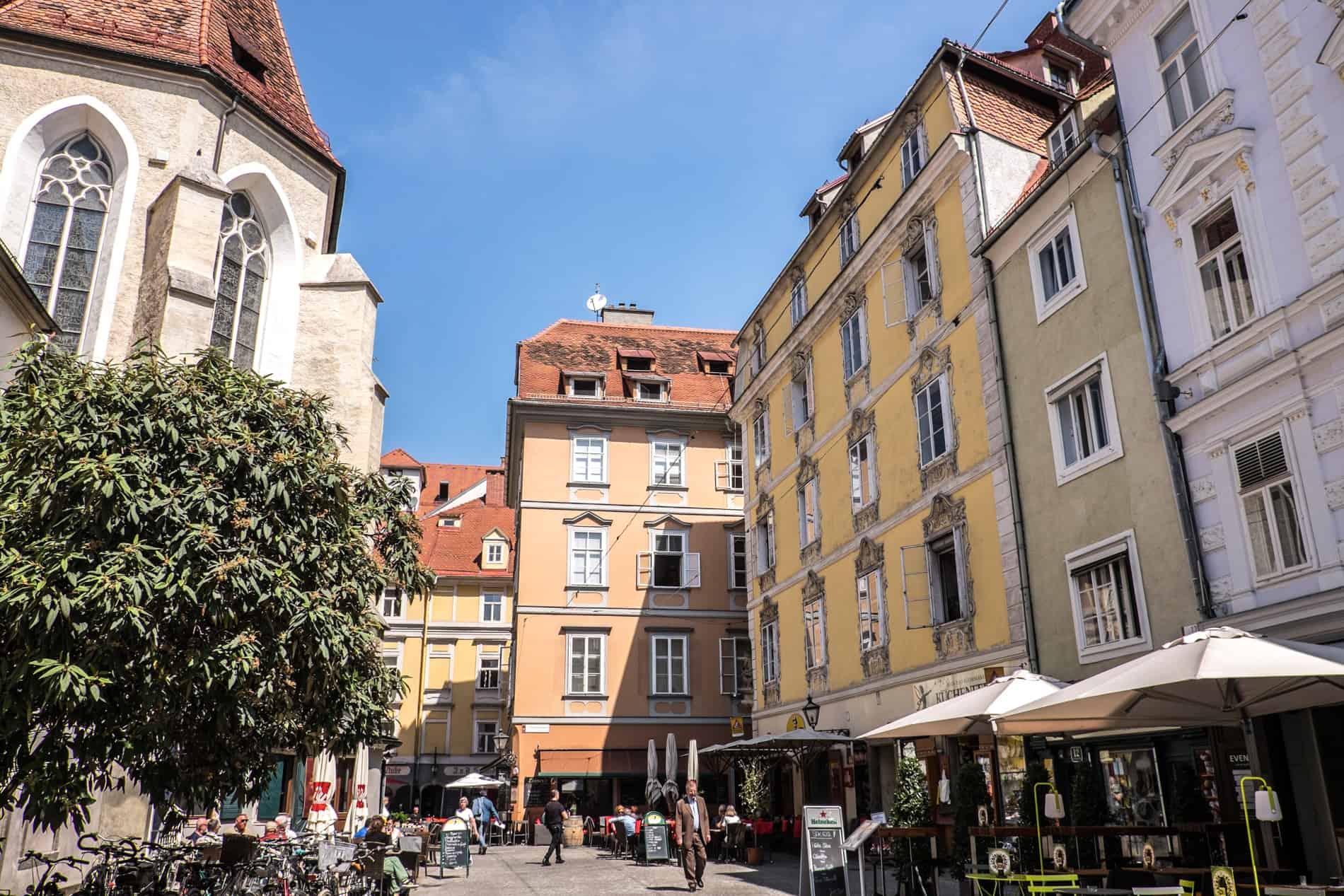
Mediterranean vibes in Graz old town.
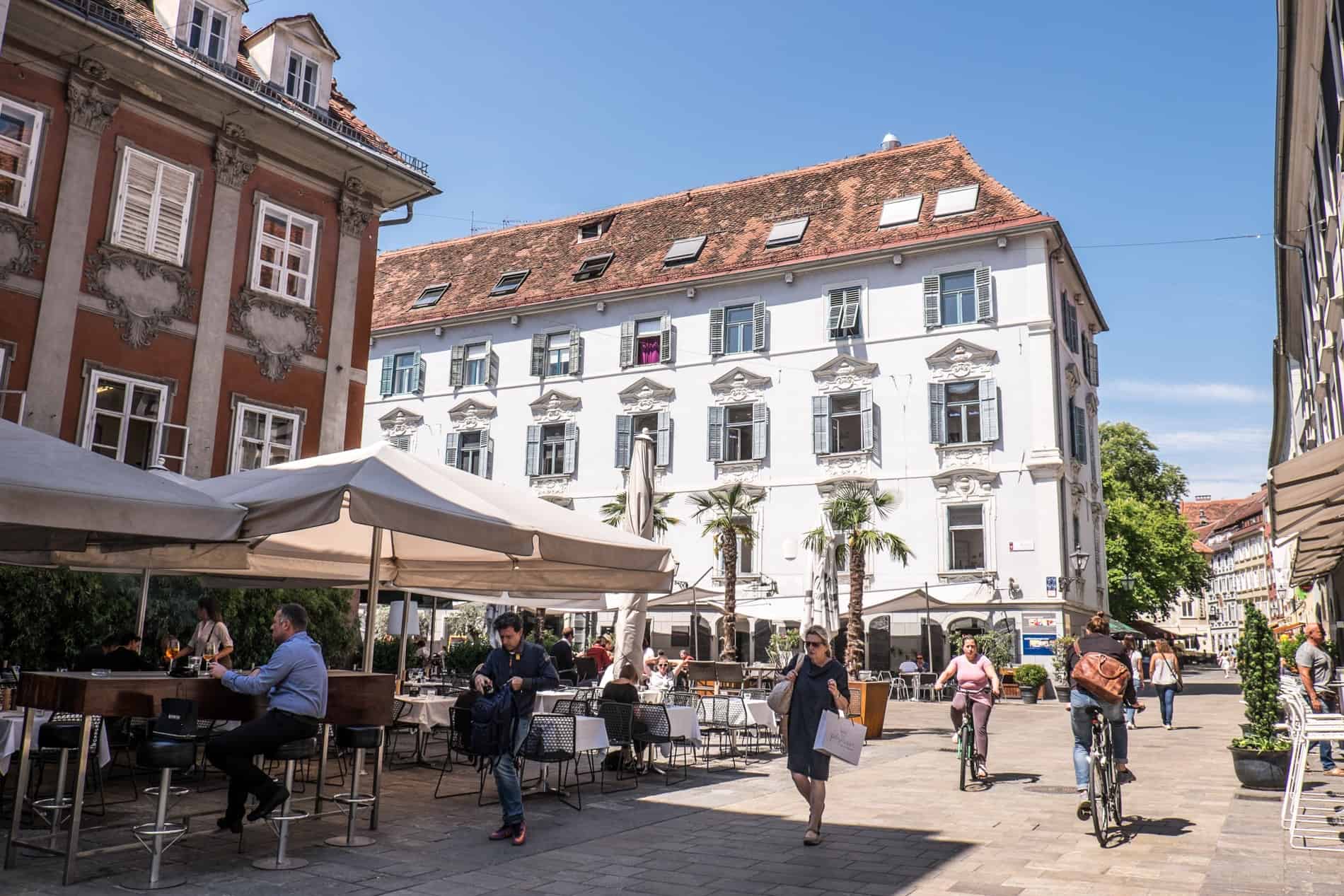
Al fresco dining and opulent buildings in the centre of Graz.
Architectual highlights of Graz include the impressive Italian Renaissance arcades of the Landhaus Courtyard, where today the Styrian regional parliament meets, the stonemasonry masterpiece that is the dizzying double spiral staircase at the entrance to the Burg, and the cluster of magnificent buildings that are the Cathedral and Mausoleum commissioned by Kaiser Ferdinand III and Kaiser Ferdinand II in Italian style.
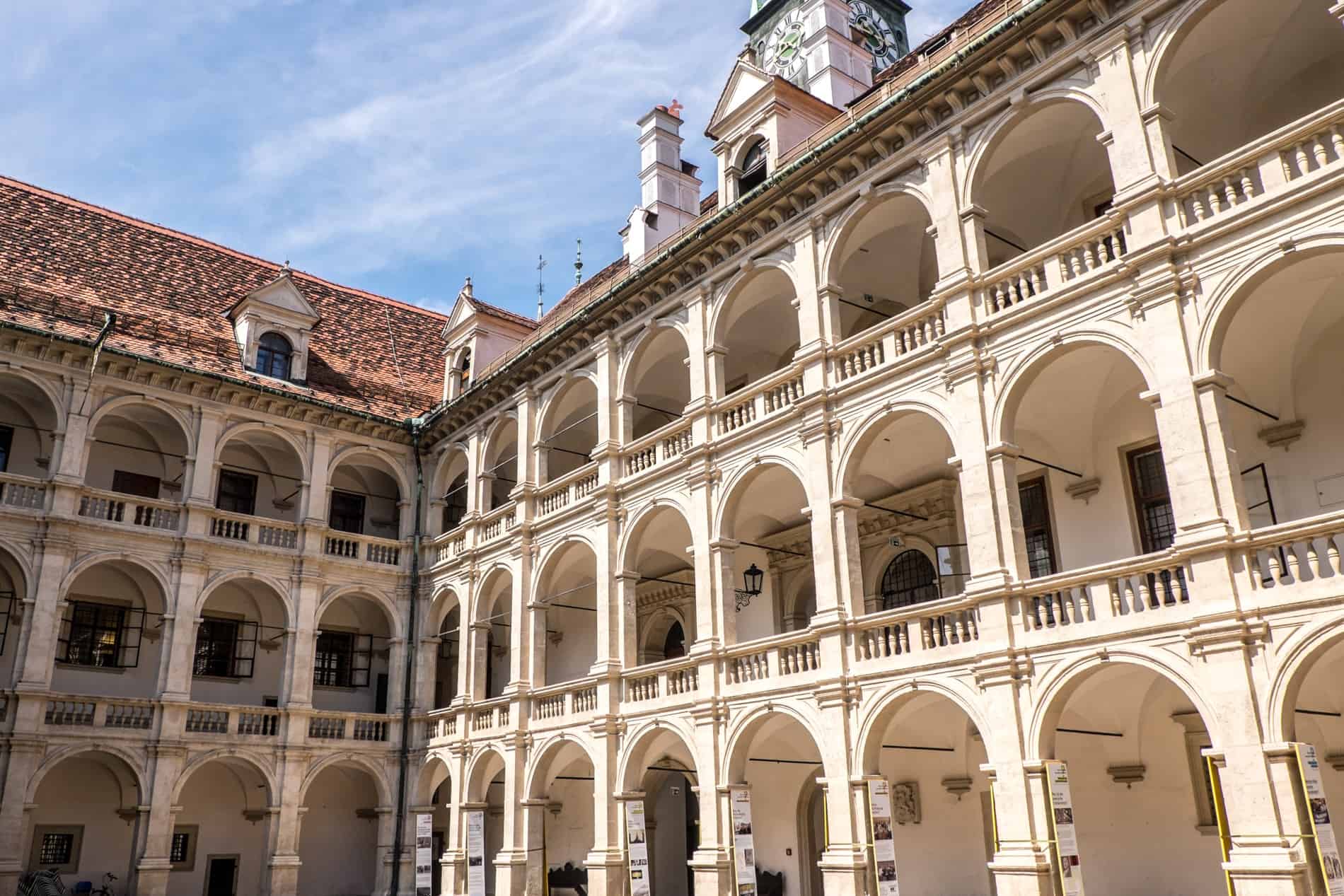
Italian Renaissance arcades of the Landhaus Courtyard in Graz.
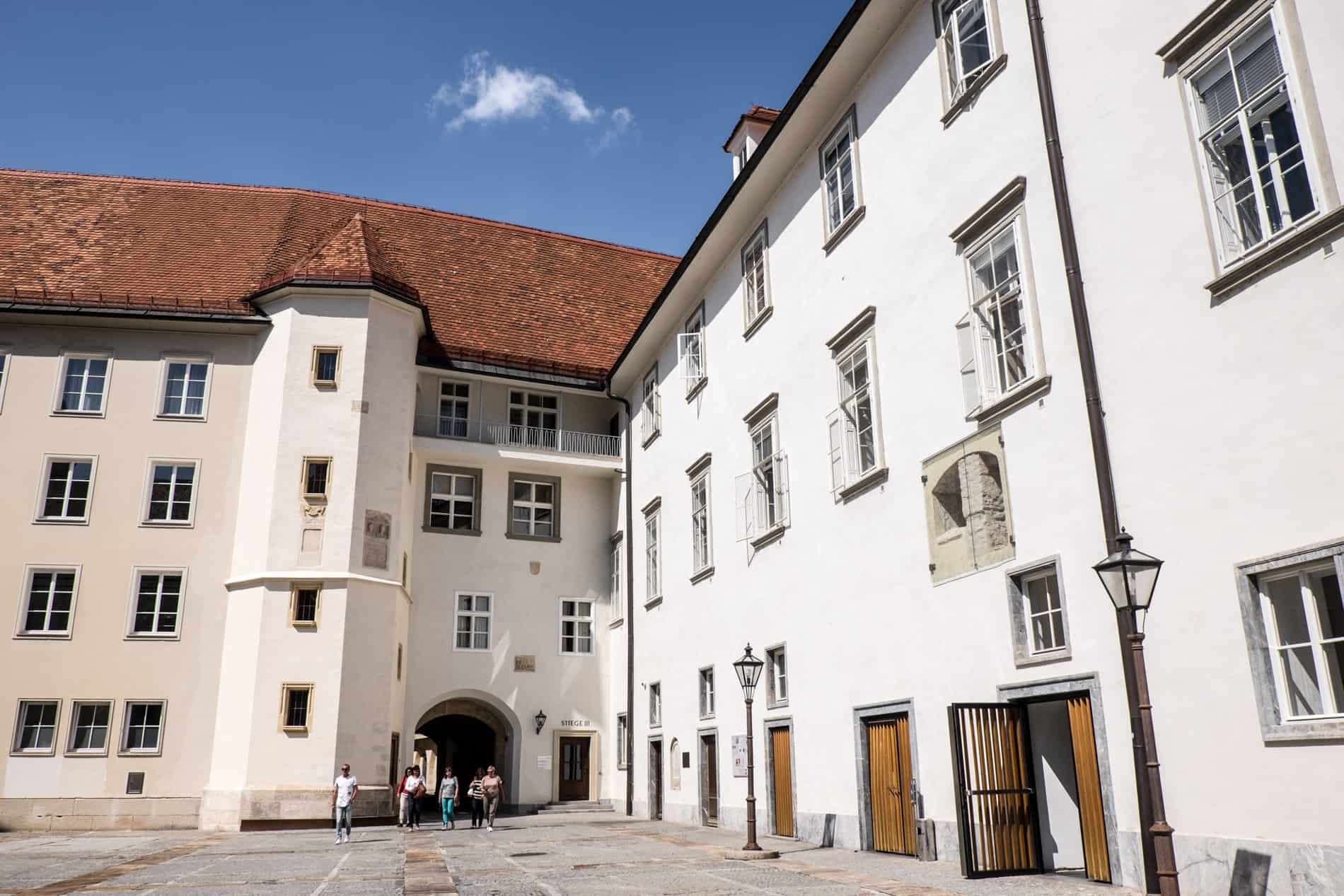
Entrance to the Burg.
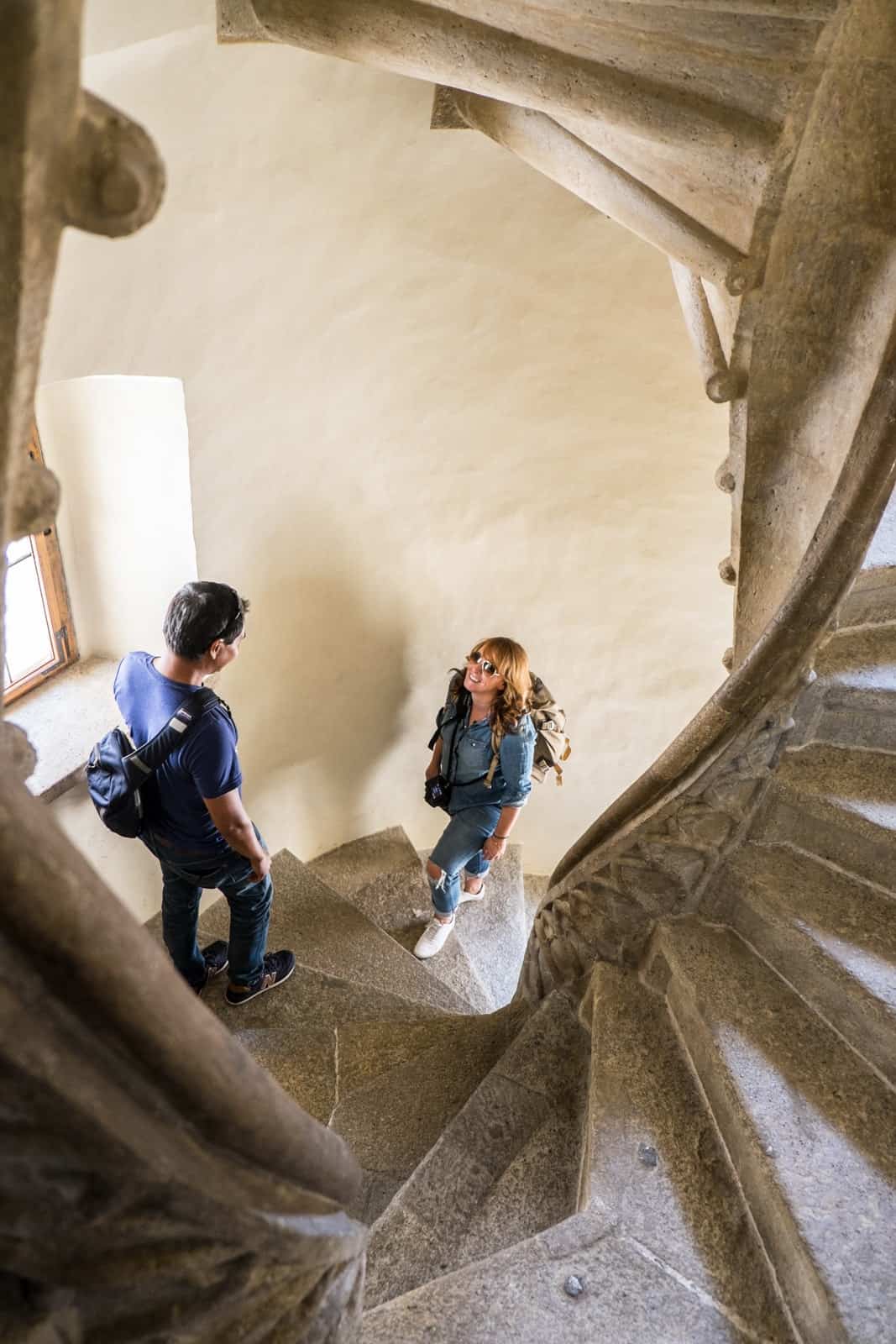
Enjoying the dizzying double spiral staircase in Graz.
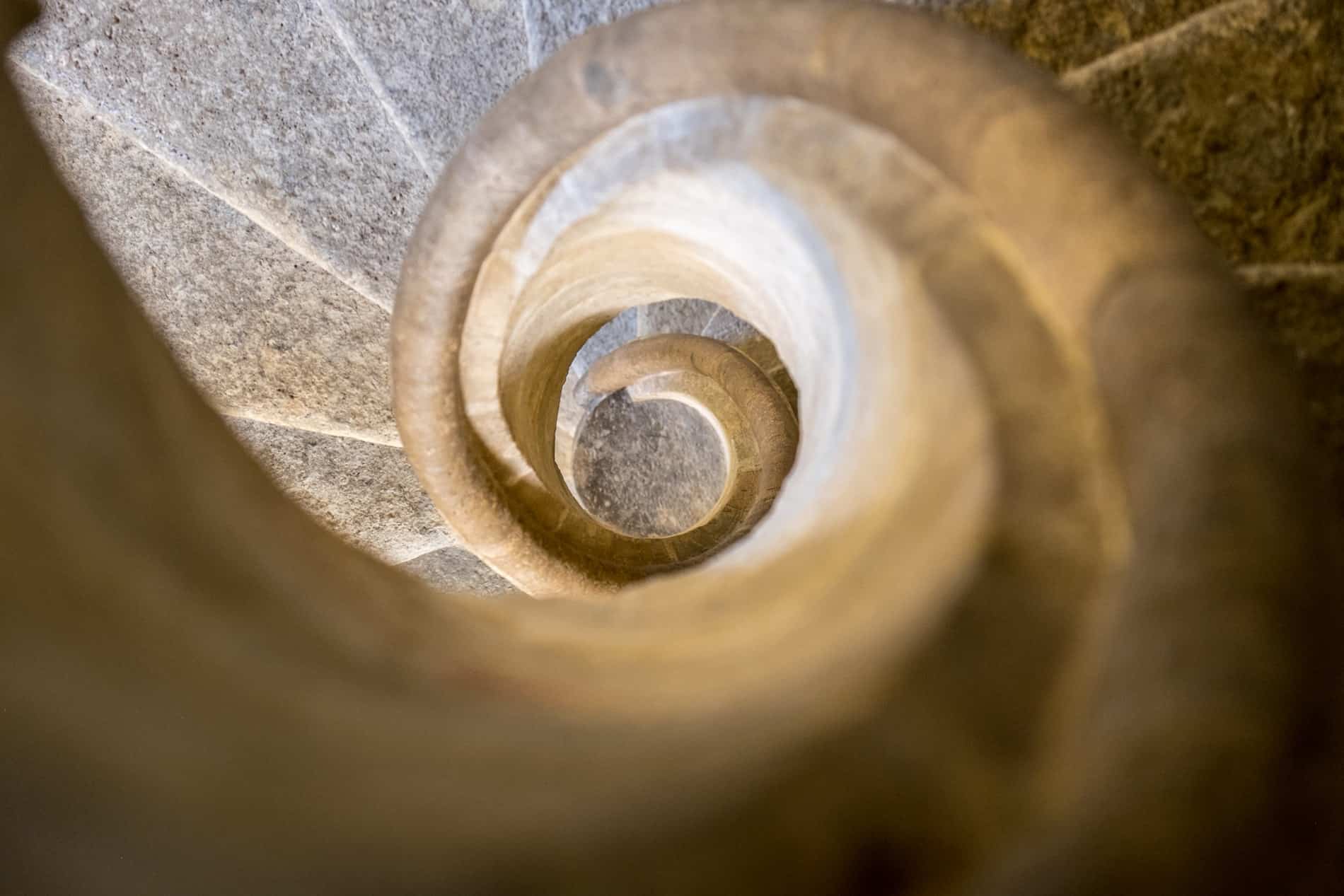
Graz’s spiral staircase in the Burg is a feat of architecture.
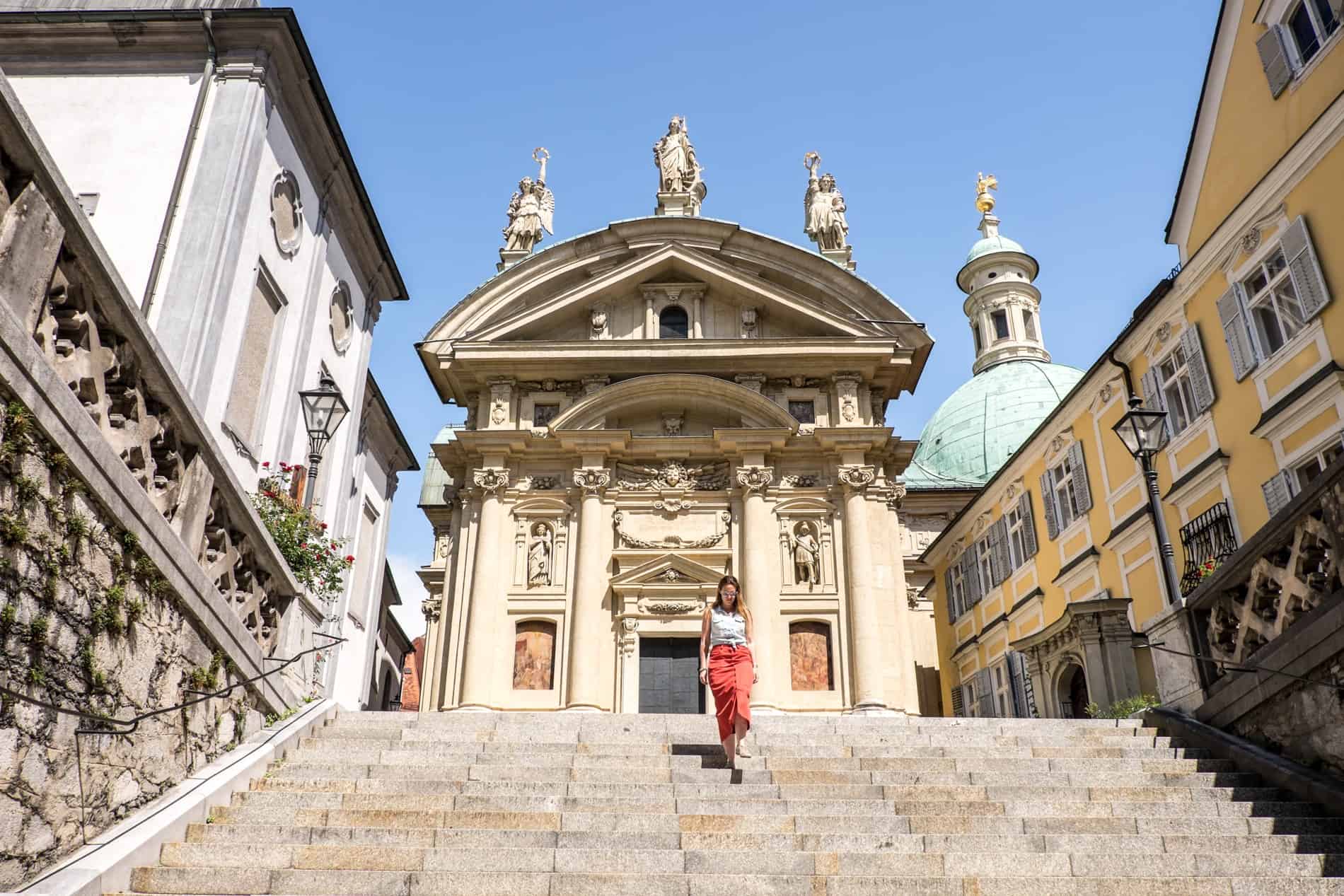
The Italian architectural style Cathedral and Mausoleum in Graz.
The Most Romantic Street in Graz Old Town
Sporgasse is one of my favourite streets that I walked the length of repeatedly. It’s considered one of the most romantic streets in the city, and here you’ll find the oldest parish church, the oldest courtyard in the city, some of the more exquisite building facades and the quirky with their legends (check out the Turk statue on Palais Saurau at number 25).
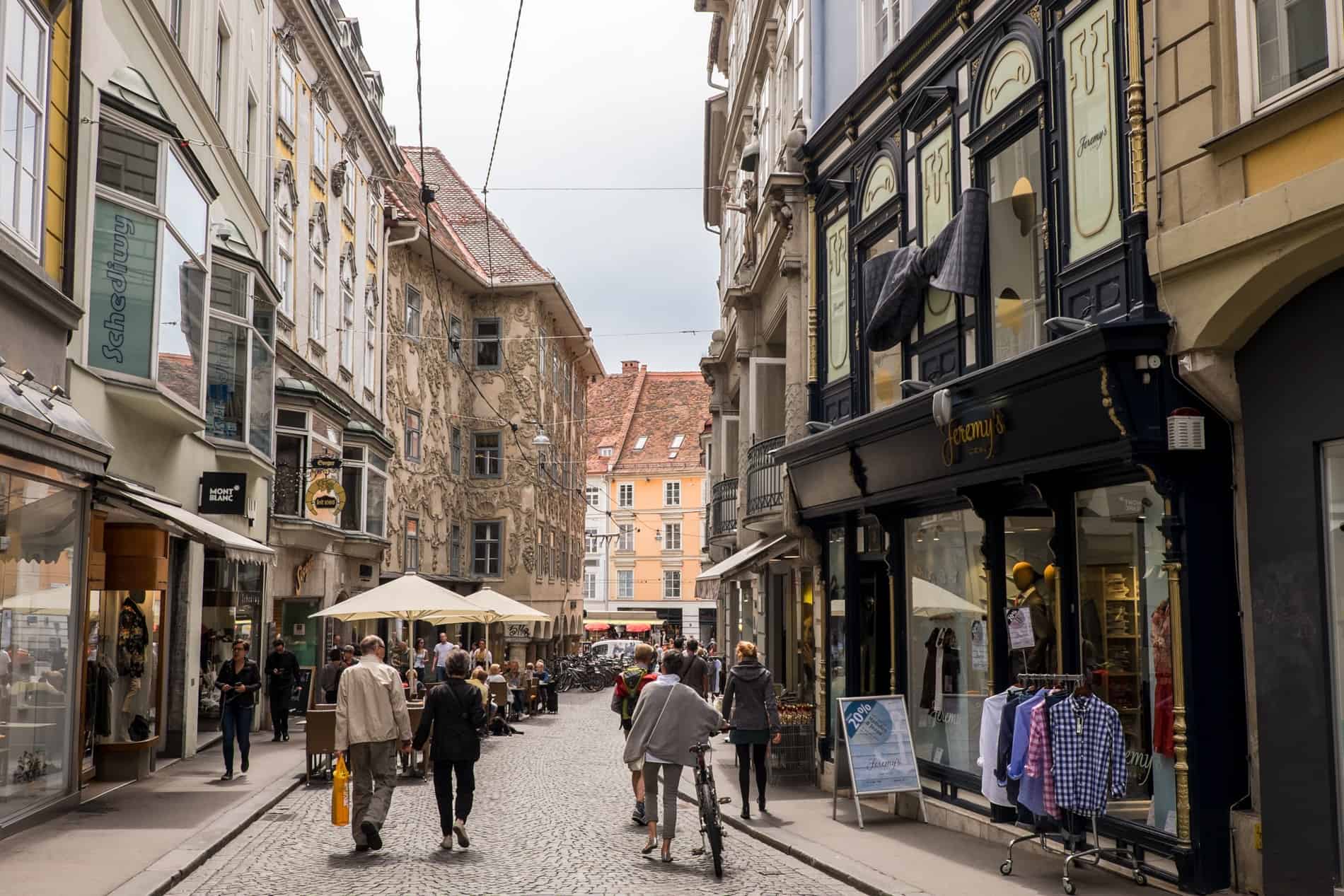
Stunning, cobblestones Sporgasse in Graz.
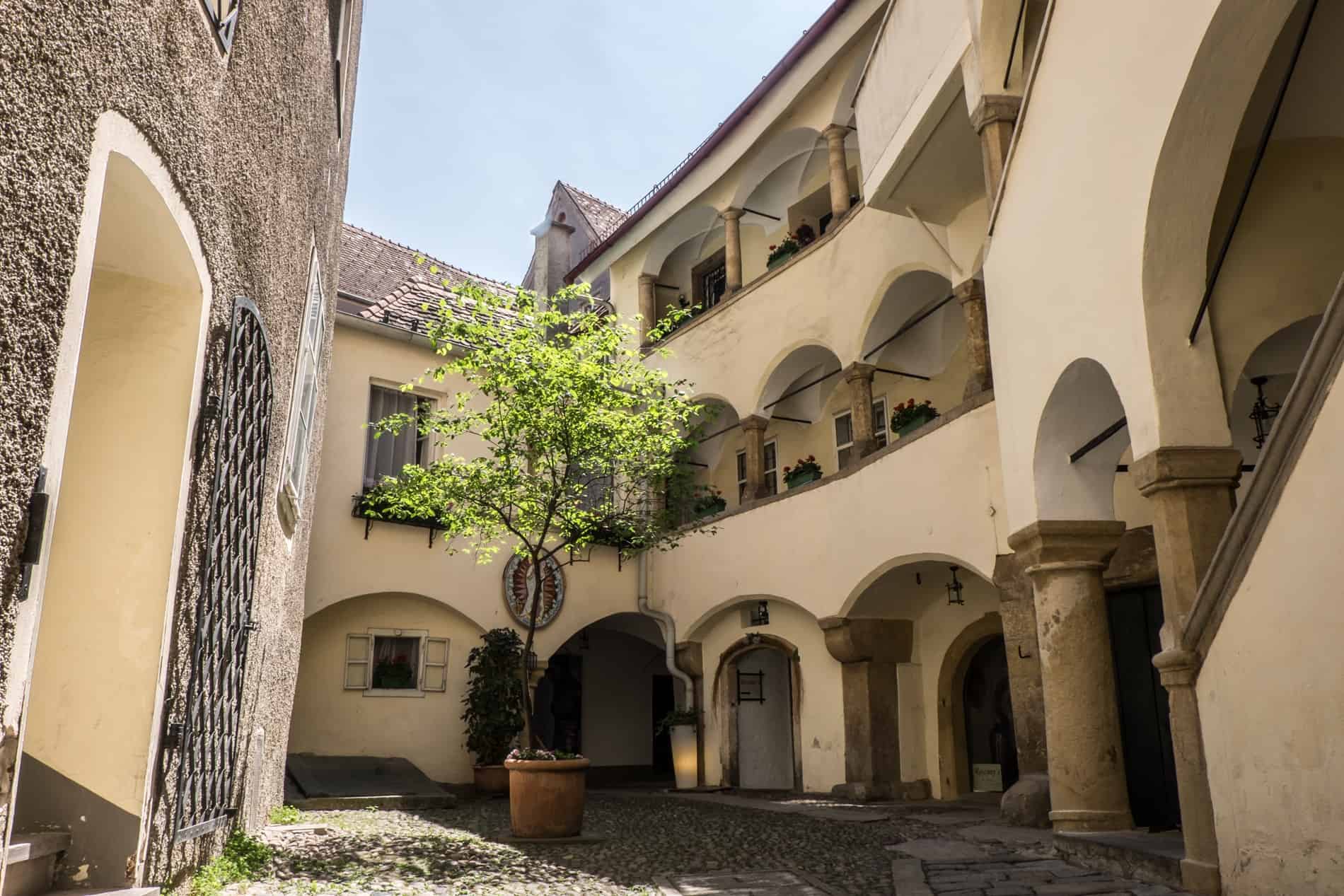
The oldest courtyard in Graz city, located off Sporgasse.
Climb the Graz Schlossberg for Clocktower Views
The 473-metre high Graz Schlossberg mound is a centrepiece of the city and the platform for the best view over the city to take in the famous sweep of orange rooftops where the creative blue bulbous ‘Friendly Alien’ Kunsthaus modern art museum has comfortably wedged within.
This green platform of trees and gardens was once the site of a small fort, giving Graz its name, meaning “little castle”, before it was extended to an enormous Renaissance fortress later destroyed by Napoleon. Bastions and an old gate remain, although people flock up here to stand next to the 28-metre-high Clock Tower, the traditional and most beloved symbol of Graz.
Connecting ground to fortress high is the 260 steps of the Schlossbergstiege for those wanting to tred more of the timeline. However, you can take a funicular up and walk down or enjoy The Slide Graz – the highest underground slide in the world that’s 64 meters tall and 175 meters long. It’s a heart-thumping 40 seconds, but a ride I would happily repeat on every visit.
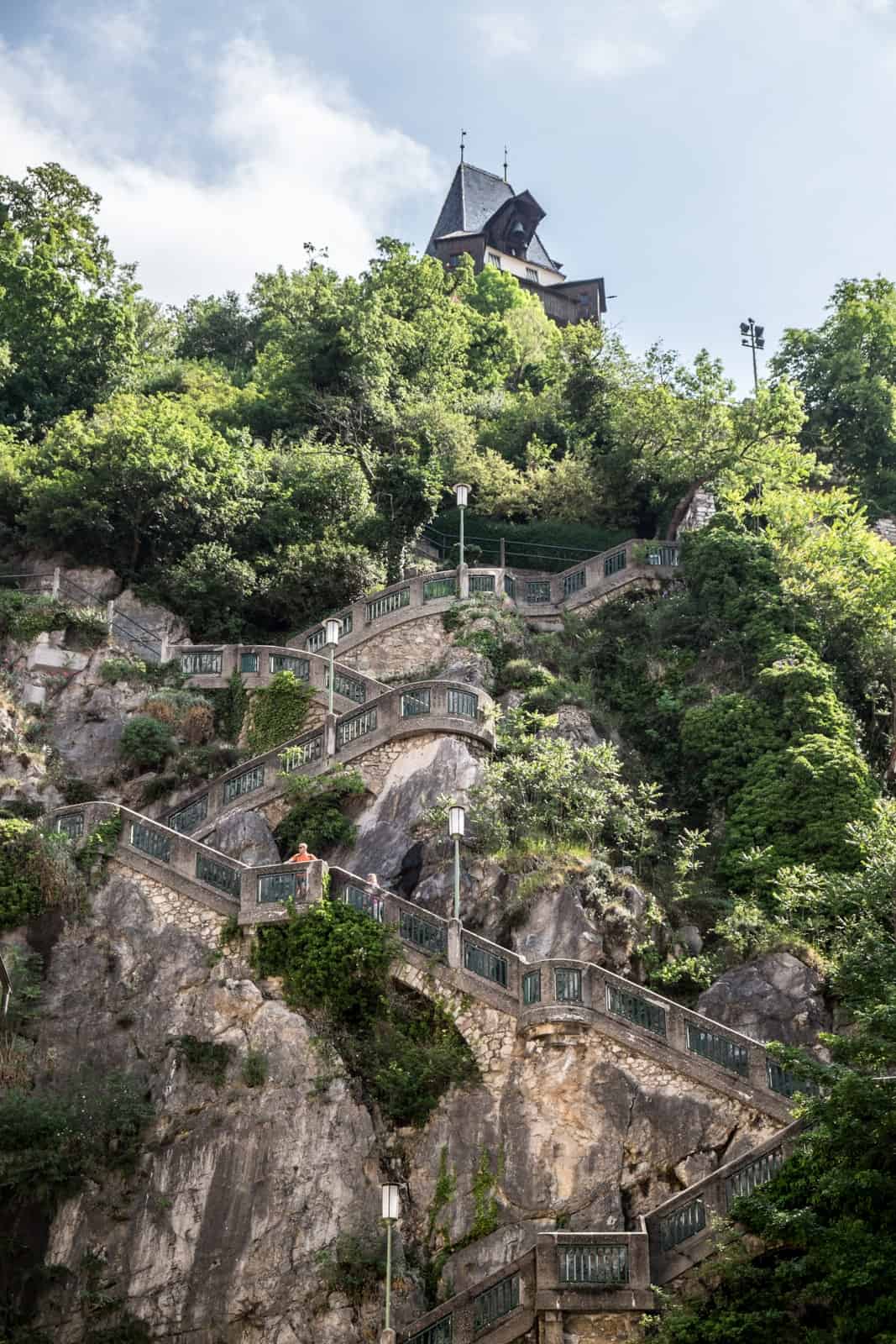
The stairs up the 473-metre high Graz Schlossberg.
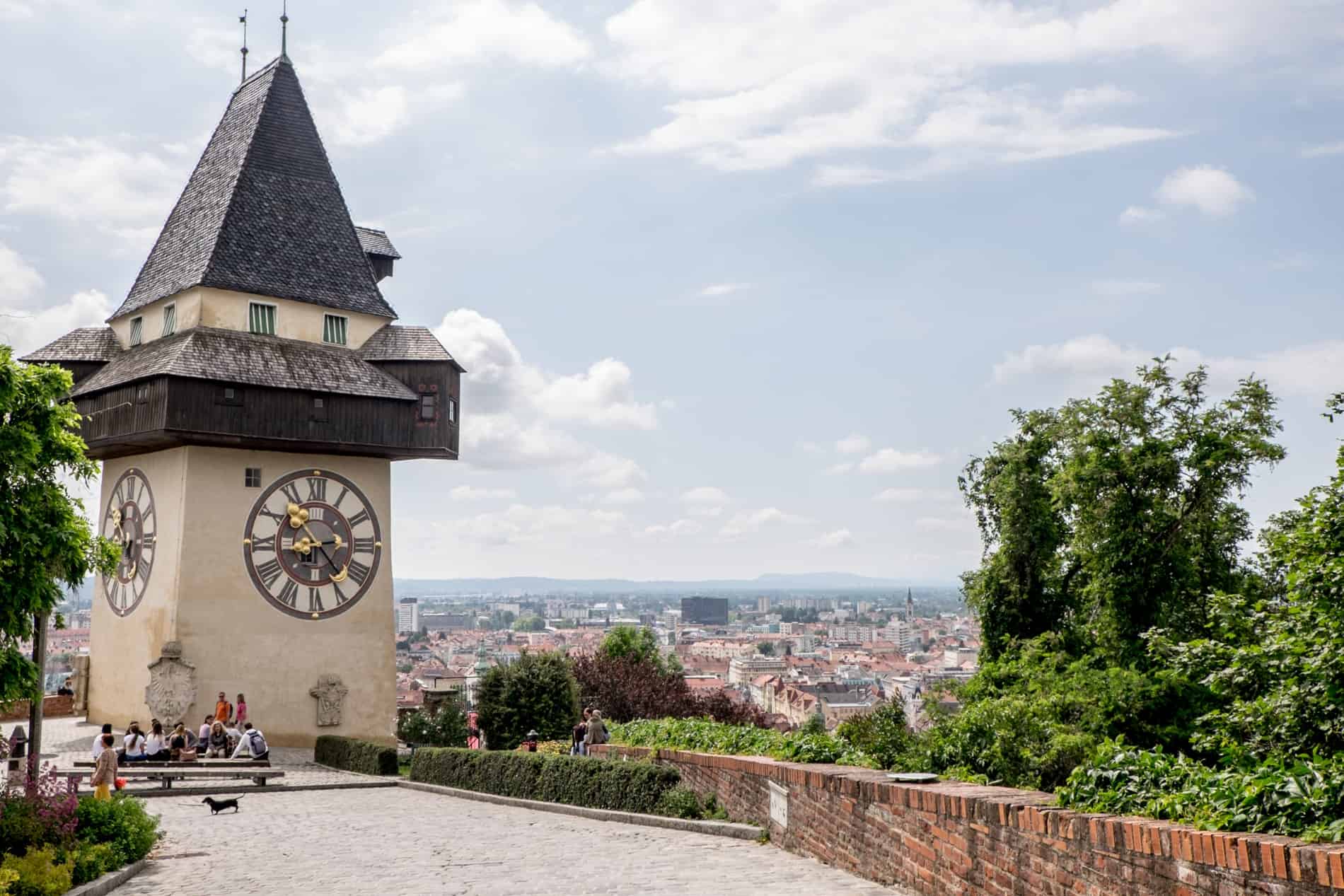
The famous Clocktower on the Schlossberg, Graz.

Get a better view of old and new Graz mixed when you climb the Schlossberg.
Historical and Traditional Eats in Graz
Want to try an old traditional hangout in the city to wrap up your historical wander?
Head to Frankowitsch, framed over the years for its open-faced sandwiches that you order with a “Pfiff” (tiny glass) of beer.
Time capsule Café König is small and a popular place for the old traditional coffee-house vibes. This café, in particular, dates back to 1918 and is decked out in dark wood, with coffee pastries and a warm, family business atmosphere.
For a panoramic city view, the rooftop of the Kastner Und Öhler department store is a favourite terrace hotspot. It is well worth a look inside for the ornate golden pillars that decorate the store itself.
Indulge at the former Habsburg bakery (the Hofbäckerei Edegger-Tax) whose wooden façade topped with a double-gilded eagle retains the same imperial decadence and offers some of the traditional sweet offerings as they were back then.
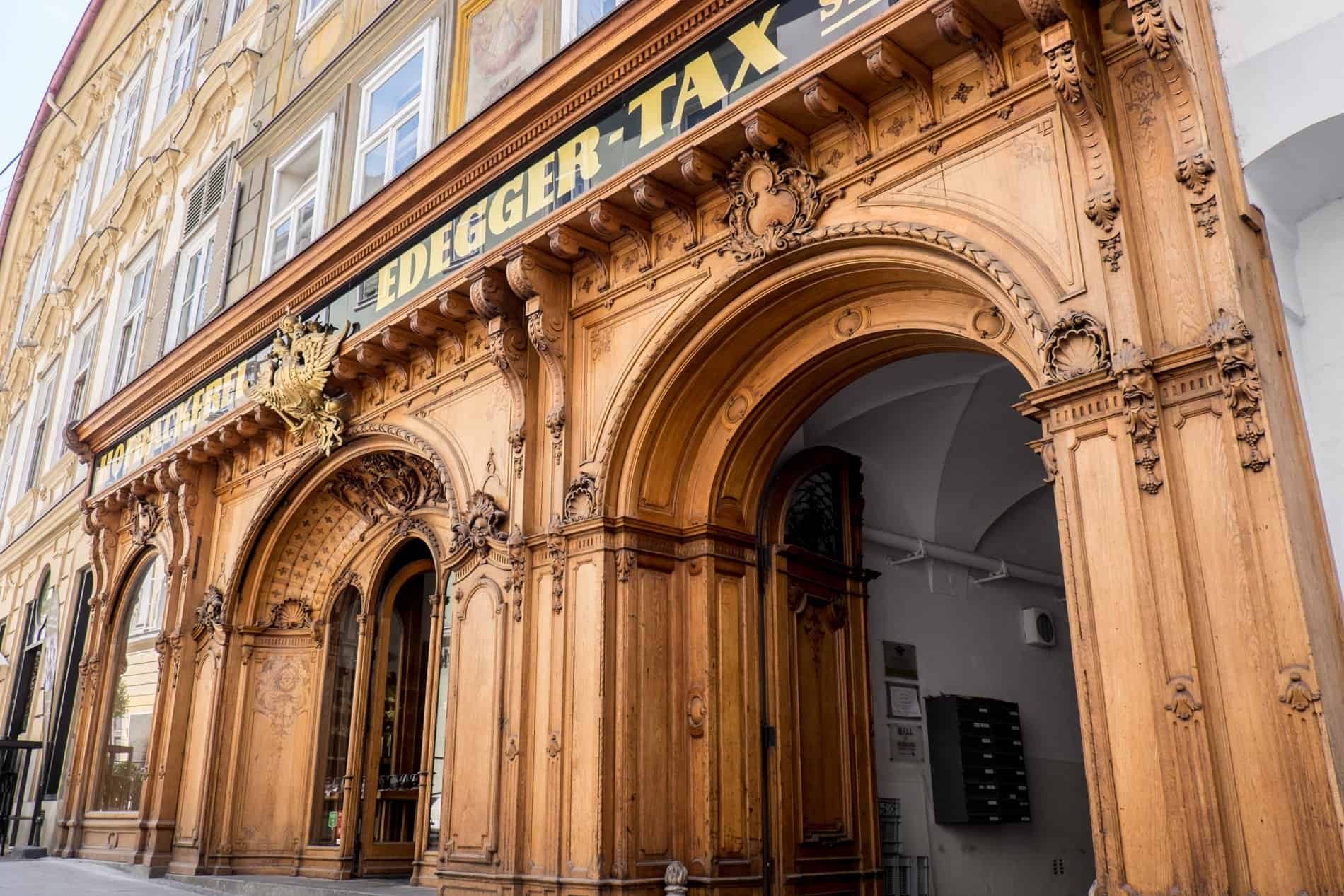
The former Habsburg bakery, Hofbäckerei Edegger-Tax.
The Creative Things to Do in Graz
Graz UNESCO City of Design
In 2011, in recognition of its creative city scene and internationally renowned educational and research institutions, Graz was designated a UNESCO City of Design.
Graz’s modern history defines it just as much as its 900 years past, but that’s not to say that this ultra-hip Graz separates itself from the old – it complements it. However, the repurposing of urban design and the burgeoning urban culture creatively and artistically makes this alternative side to Graz a destination in its own right.
Start at Grieskai street, adjacent to the Mur River. It is the road that virtually splits Graz in two with the historical old town on one side and trendy new on the other. Crossing the River Mur and exploring a whole new side of Graz that lies right behind the ‘Friendly Alien’ landmark completes the picture as to the city’s origins, cultural diversity and artistic heart.
Visit the Friendly Alien Modern Art Museum
Graz’s loved and revered modern landmark is the Kunsthouse (modern art museum), built in 2003. It’s otherworldly, spaceship-like features have come to make it affectionately known by locals as the “Friendly Alien”. You can’t miss it, and I was obsessed with this architectural bubble before I even arrived.
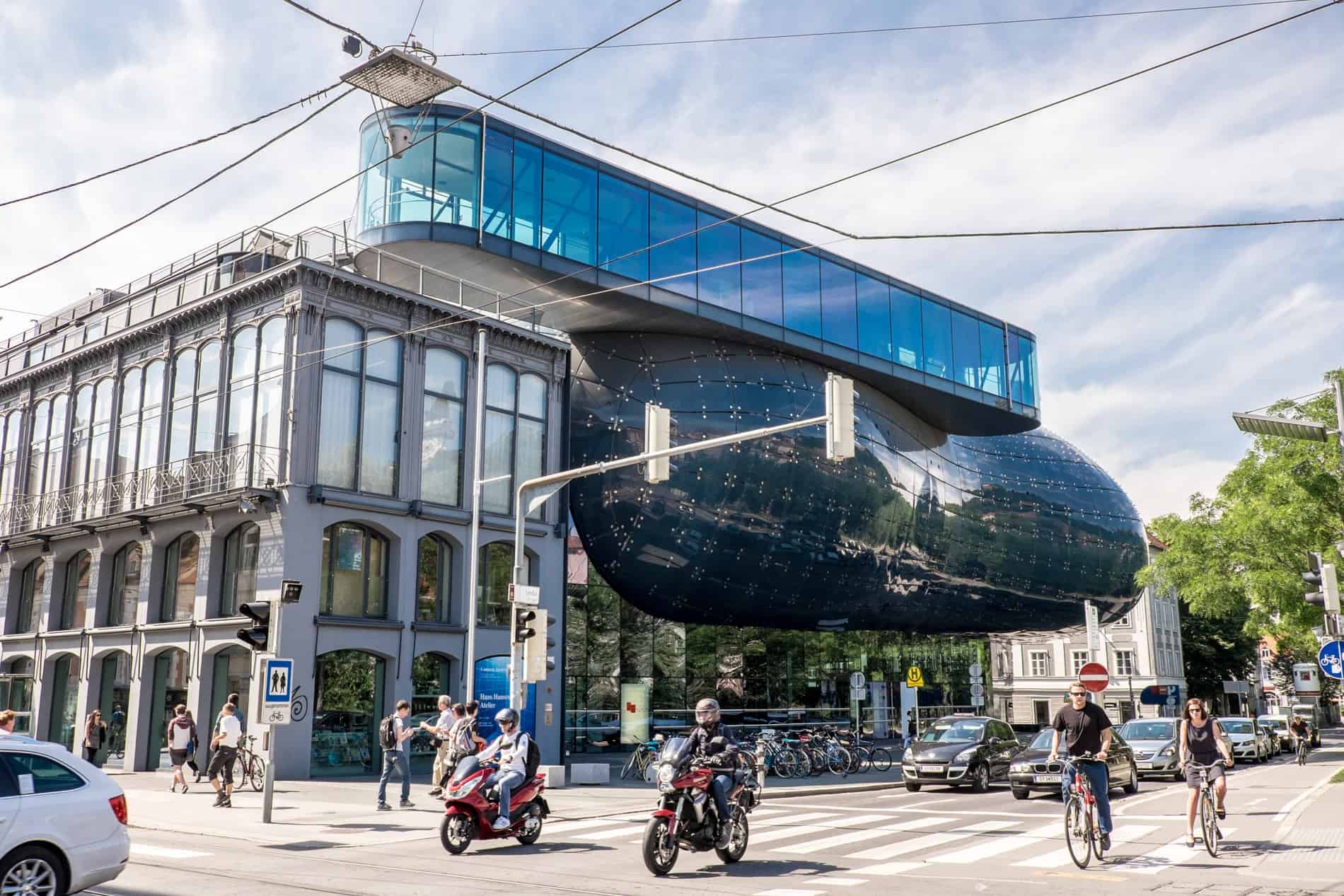
The “Friendly Alien” Kunsthouse modern art museum.
While the ledges of the Schlossberg look down over this area, this side of the river looks up. Inside the Kunsthaus is an artistic window viewpoint. One of its ‘nozzle’ windows points in a different direction to all of the others – for an old to the modern facing view of the famous Bell Tower on the Schlossberg.
It’s a nod to the city’s history from the perspective of the new design. Return to the Friendly Alien at night, when it becomes an interactive light and art installation that’s always changing, much like the enclosed exhibits.
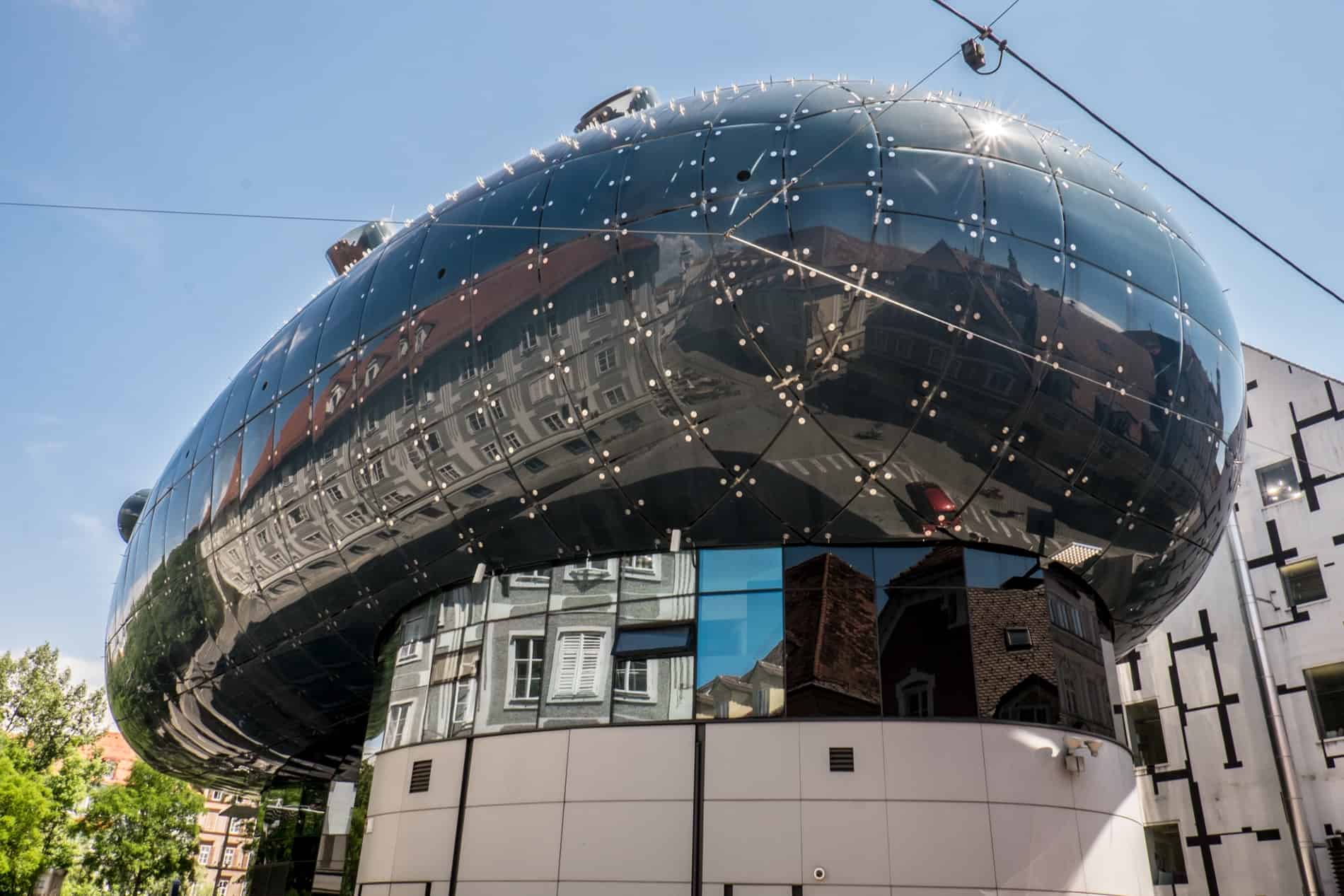
The seemingly floating Friendly Alien of Graz.
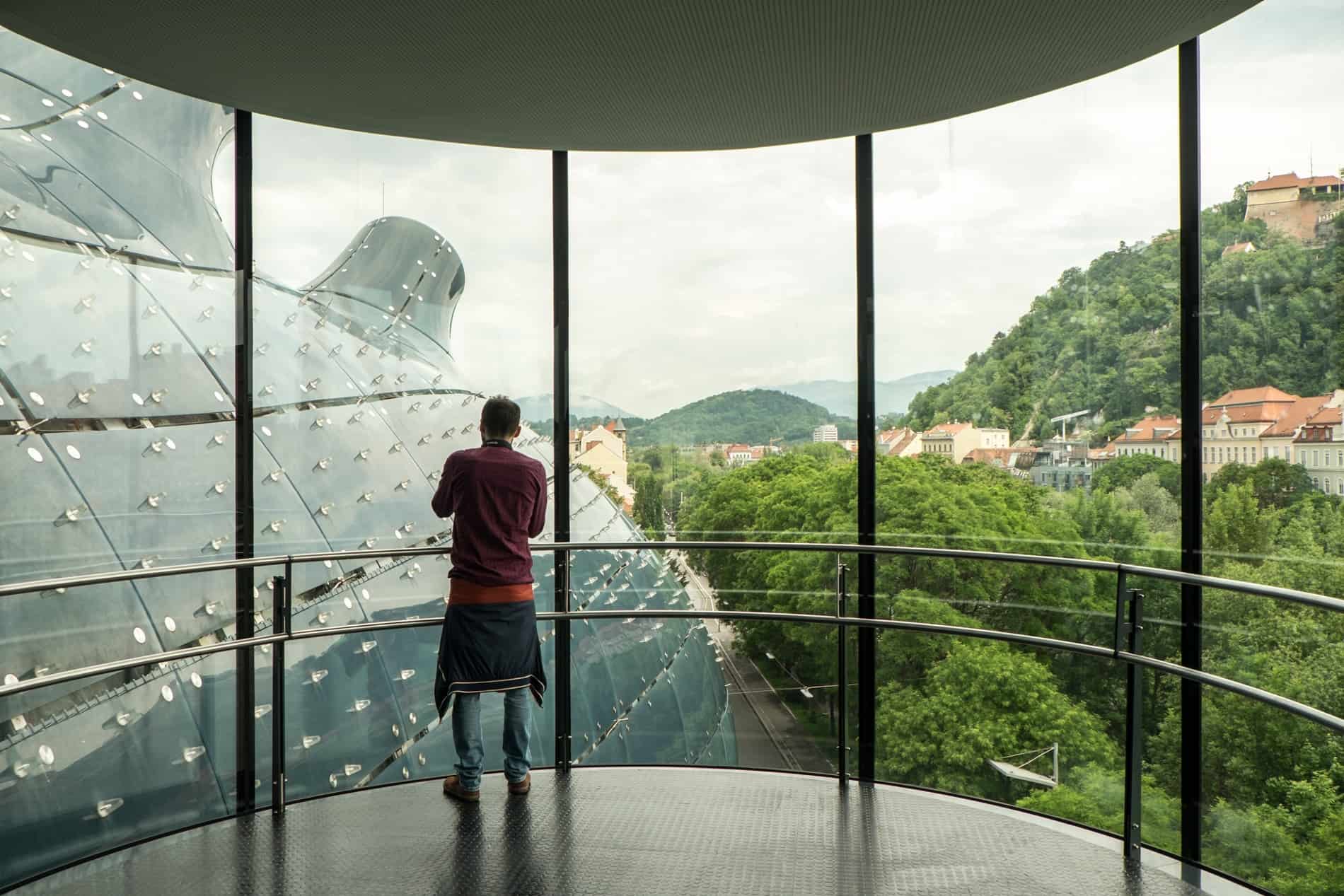
Inside the Kunsthaus modern art musuem in Graz.
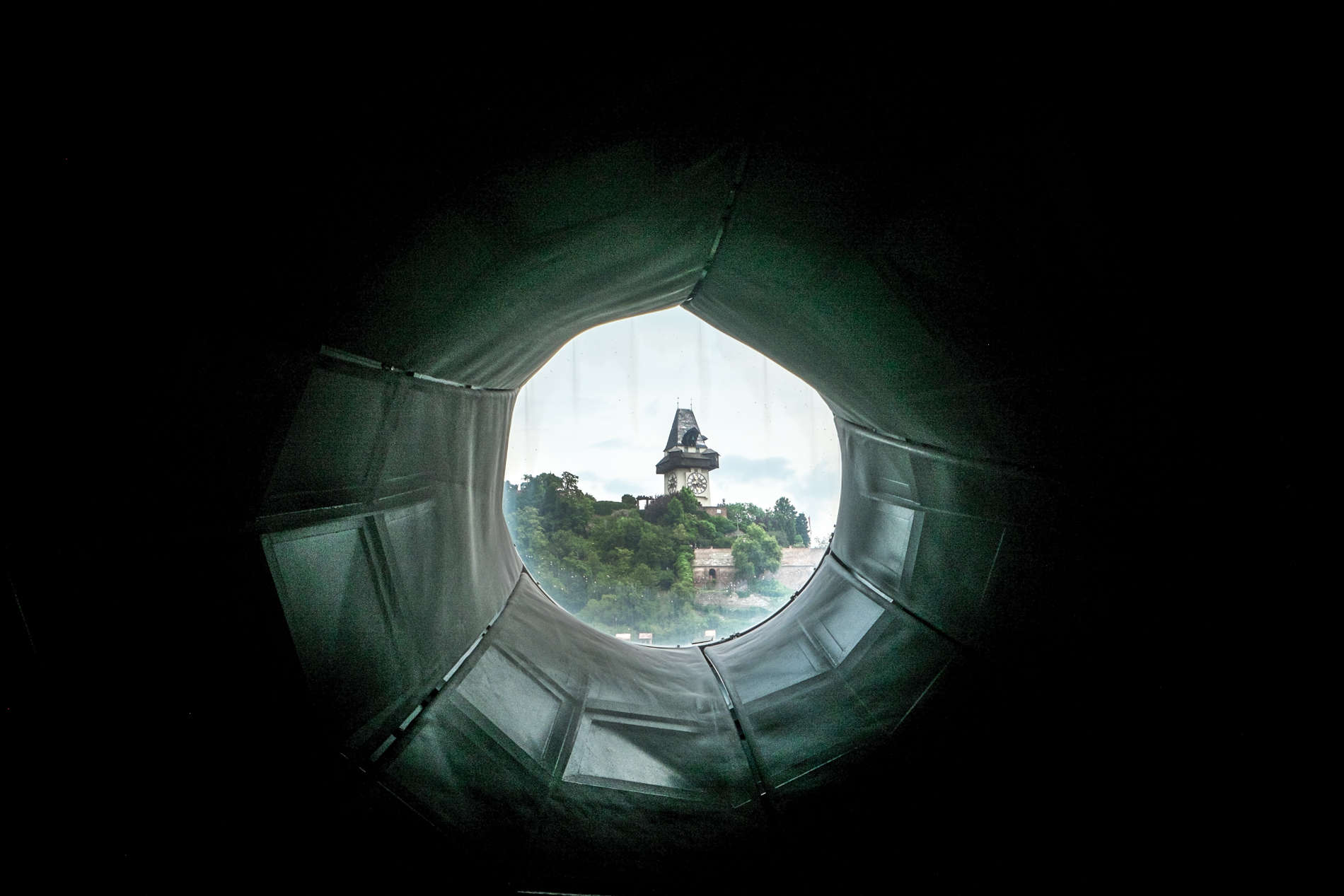
View of the Graz clocktower from inside the Kunsthaus.
Immerse Yourself in the Lend Neighbourhood
This side of the river meshes with the ultra-cool vibes of the Lend neighbourhood. The area of Lend starts in the area around Mariahilferplatz, whose history dates back to the 19th century when immigrants from Yugoslavia and Turkey settled here, bringing together multiple cultures, cuisines, communities and commerce.
It’s a natural trend for the creative-minded to be attracted to the underdog areas; the gritty and unknown. It’s an area granted a new lease of life from what was once a place seen as discarded and unkempt; the regeneration of the old red-light district area into a new form of an entertainment district.
Lend is the kind of alternative locale. With enough boutique and eco initiative stores, new-gen coffee shops, bohemian and swank restaurants side-by-side, a weekly farmers market in Lendplatz on Monday-Saturday until 1 pm and edgy, casual bars that you could easily spend a day in without stepping foot in Graz’s old town.
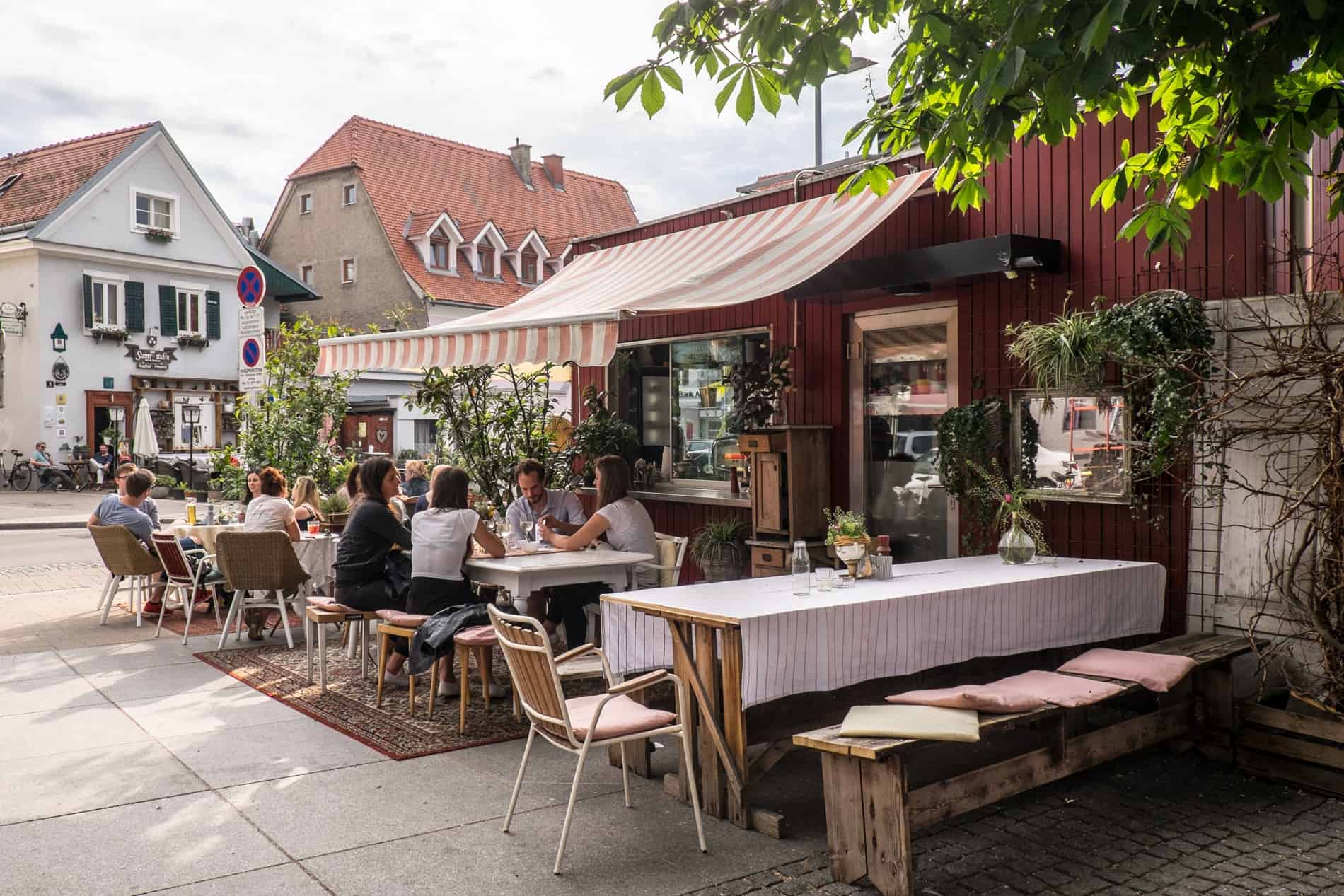
Relaxed eatery at Lendplatz in the trendy Graz neighbourhood of Lend.
In the evening small clusters of casual pubs and urbanite bars, and late-night foodie spots like ‘Brot und Spiele’, give it a homely and ‘in the know’ neighbourhood feel. The hipster bar, Kabuff is a play on the area’s past, meaning ‘no brothel’ in Styrian dialect. Lendplatz hums with people coming together at the hole-in-the-wall bars where the atmosphere is more energetic.
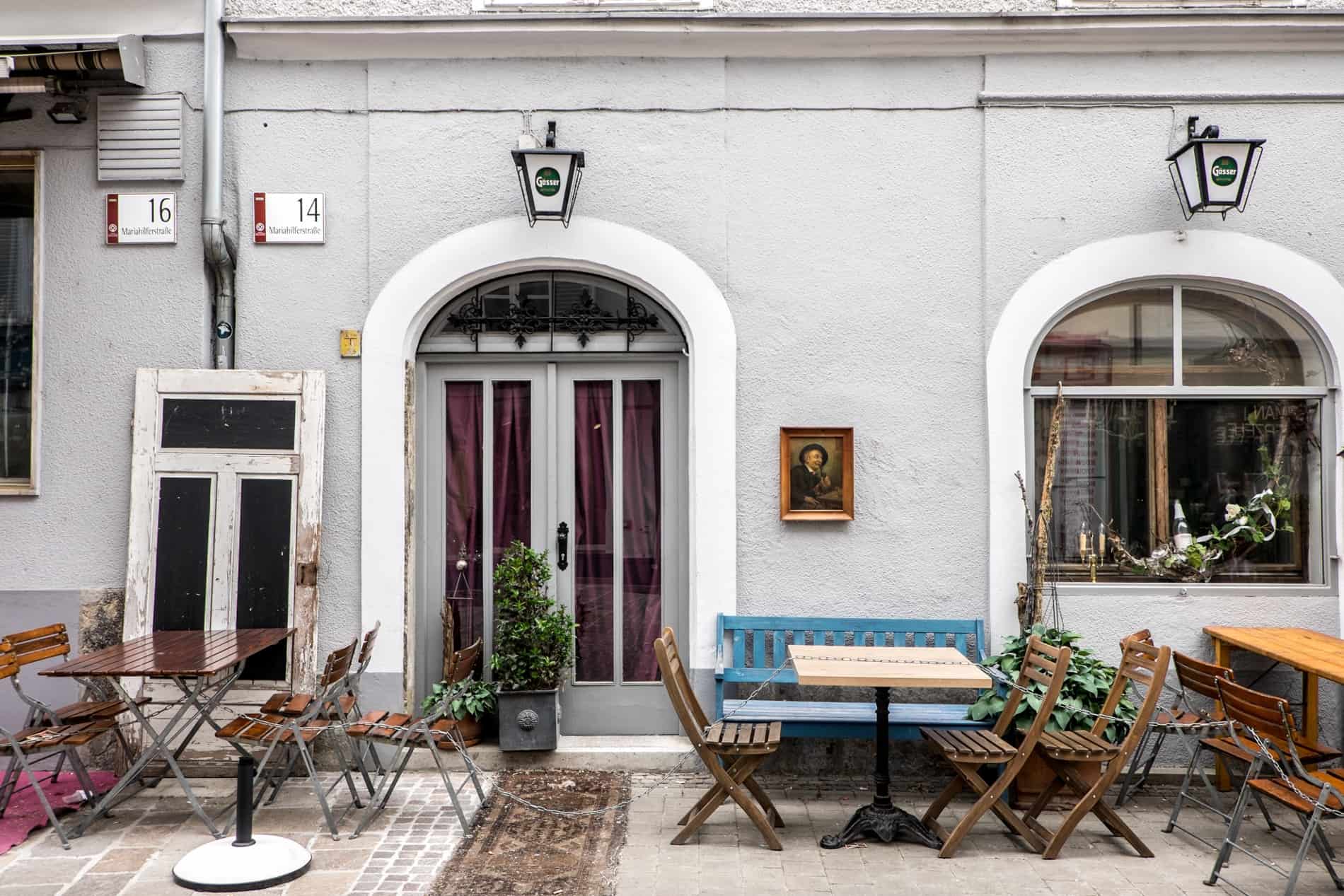
Restaurant with quirky artistic decor in Lend neighbourhood in Graz.
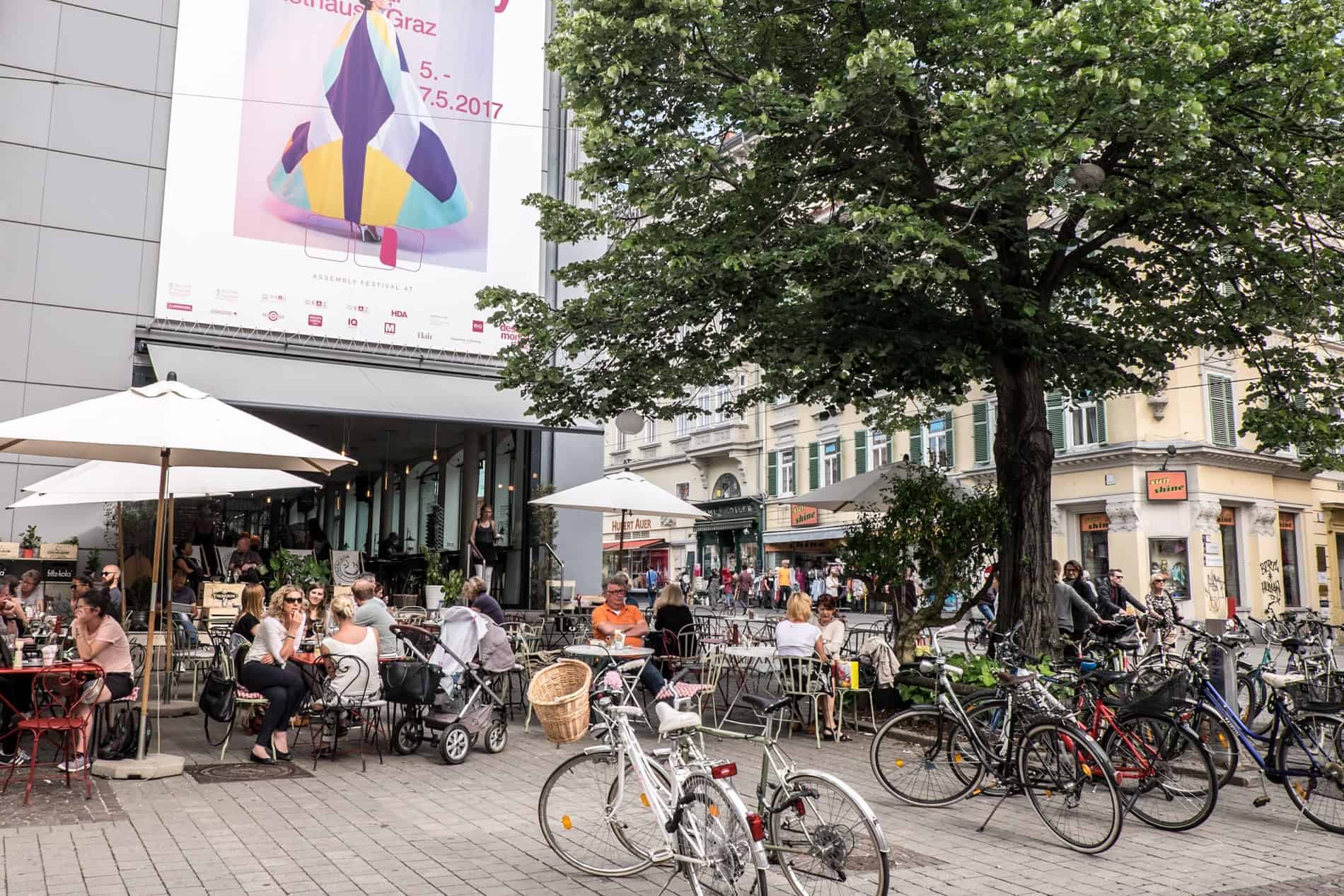
Trendy hangouts in Lend.
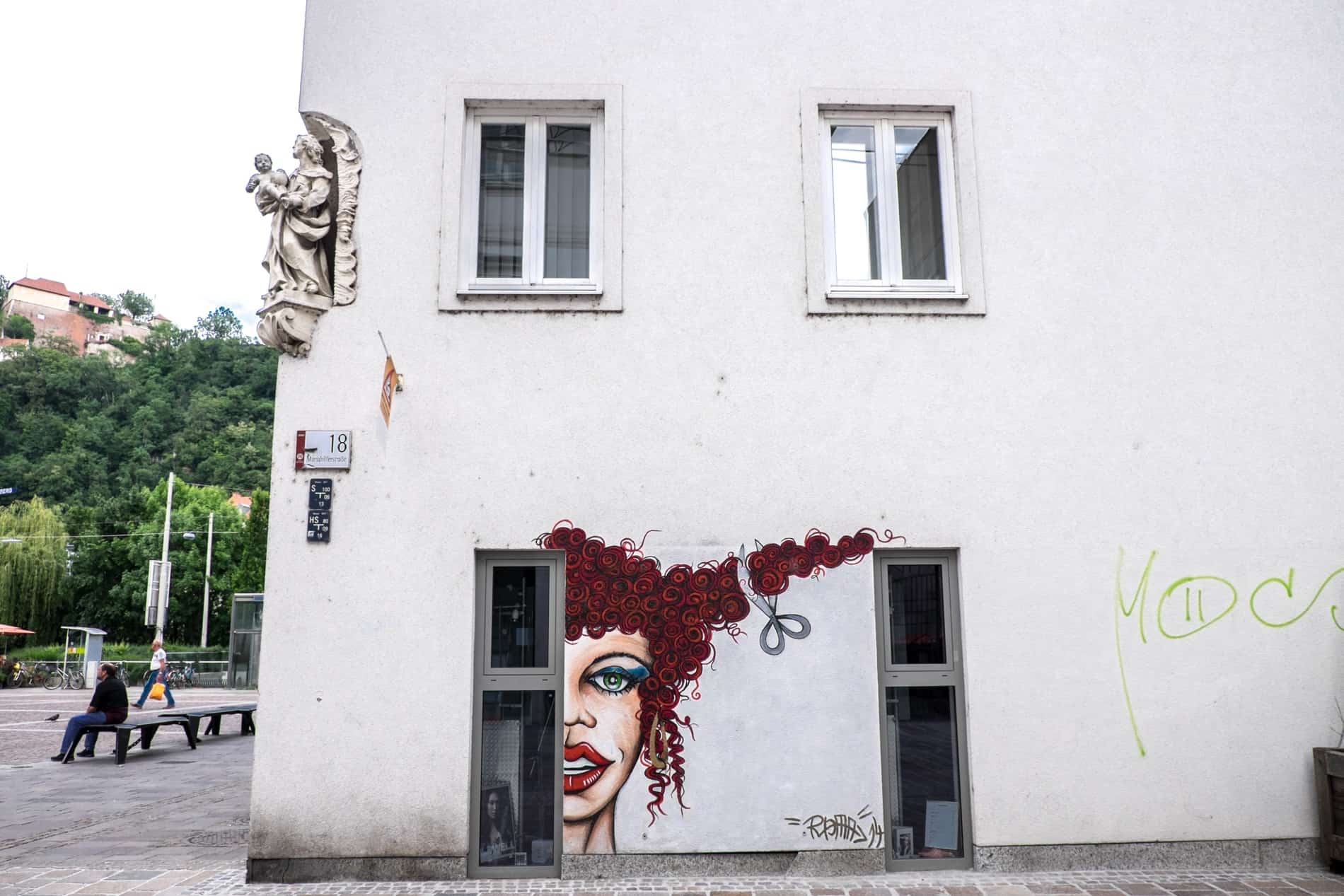
Street art on the edgier side of Graz city.
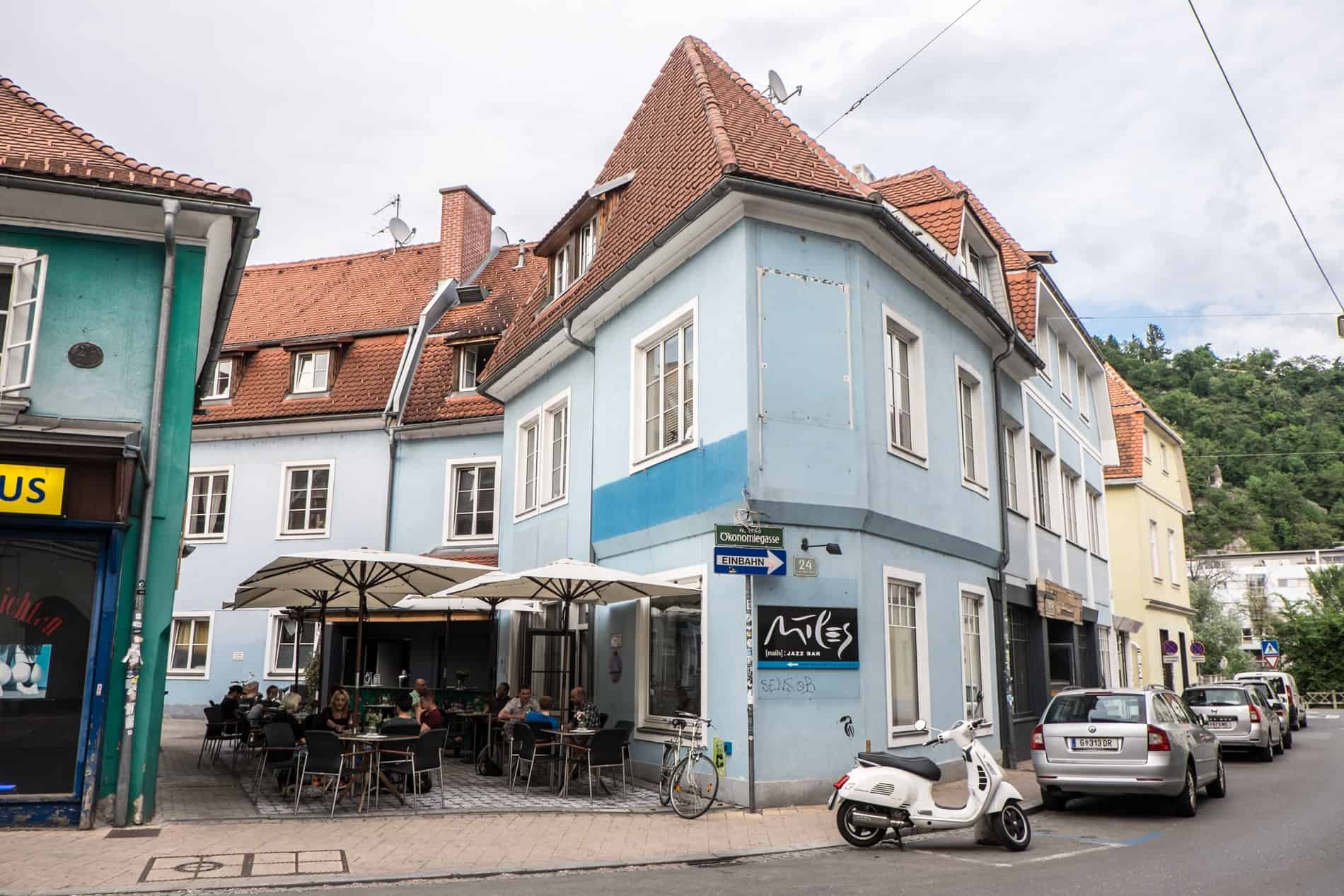
Miles Jazz bar in the urbanised area of Graz.
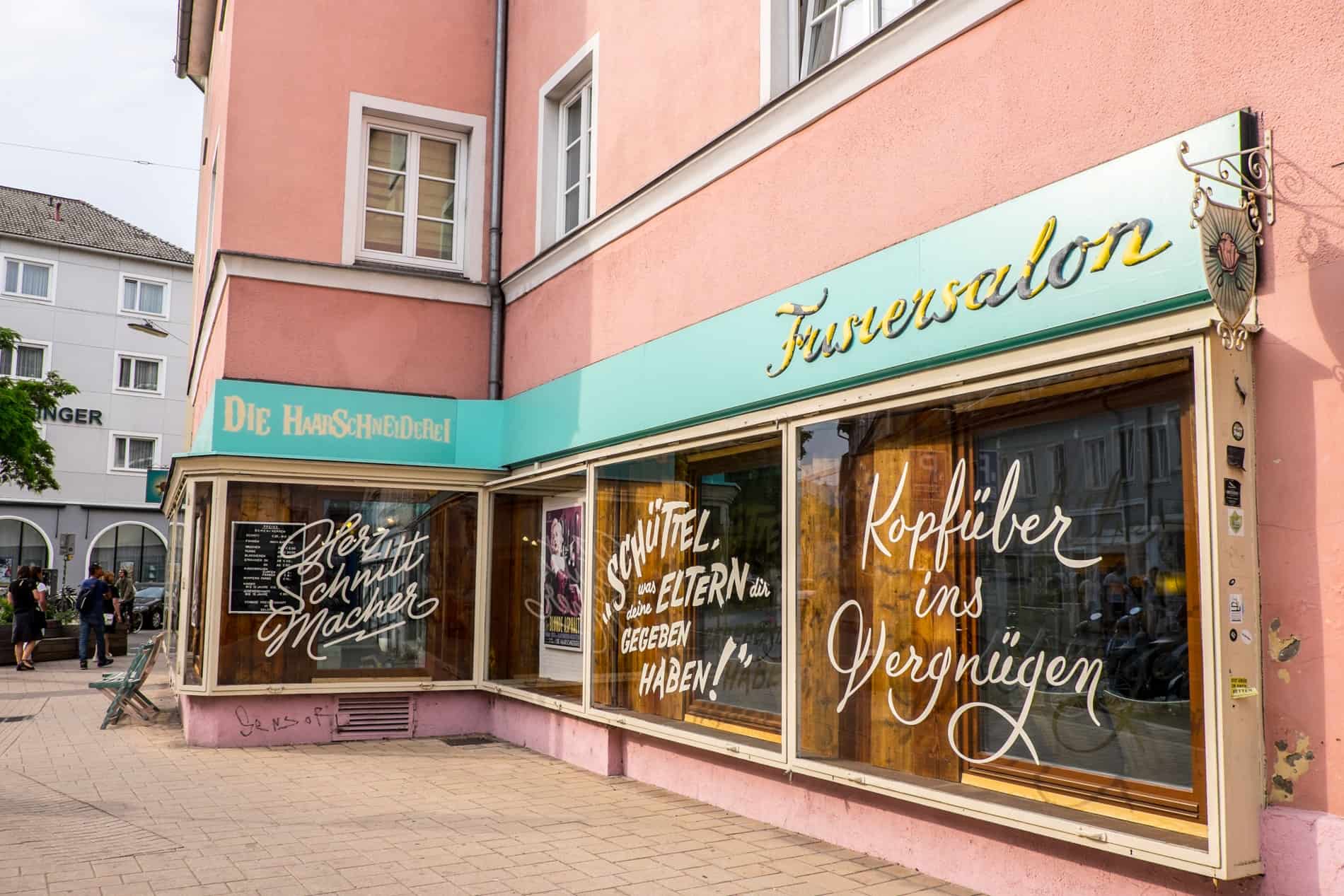
A 60s style hair saloon in Lend.
The social-impact led, charity design shops are at the very heart of this creative side of Graz, selling all kinds of upcycled items from fashion, jewellery and homeware. Yet the focus on the design projects is that they focus on youth employment and the involvement of young locals, which means when you shop here, you are a part of a full-circle initiative.
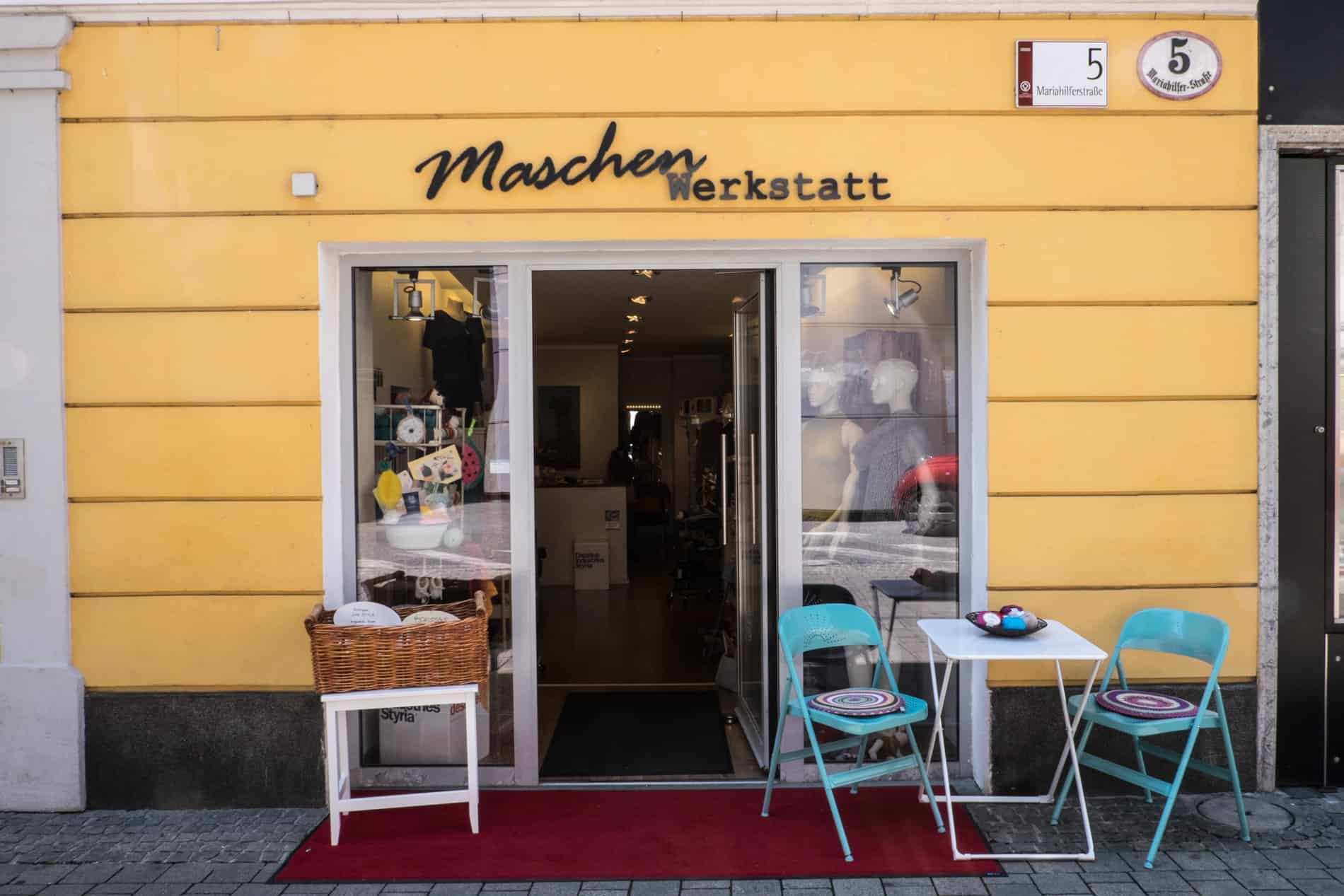
One of a cluster of design charity shops in Graz.
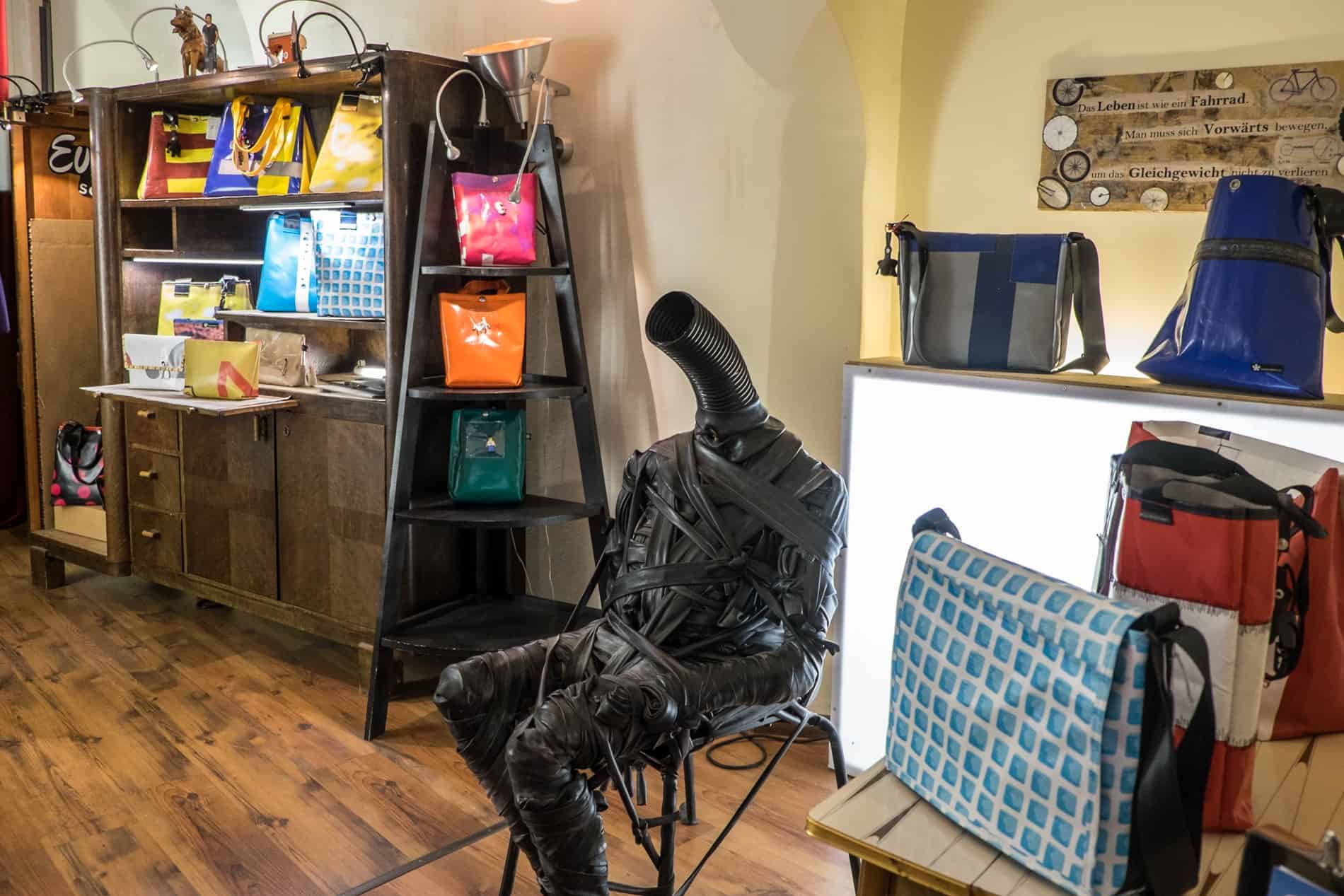
Find plenty of upcycled stores on this side of town.
In Lend, there are pockets of street art, buildings painted in a myriad of colours and patterns, the church of St.Andrä that combines religion with contemporary art, and repurposed old spaces that make for bohemian hangouts, expanding and adding colour and life to an area once on the sidelines of old, historical Graz.
An area built on multi-culturalism, Lend thrives on community spirit. The annual Grieskram food and performance festival brings everyone together, and the socio-cultural project, Annenviertal, encourages Graz locals to take part in community activities to drive interest and awareness in new business and neighbourhood initiatives to keep the area on the map.
As a visitor, you are just as much a part of keeping this side of the Mur River alive.
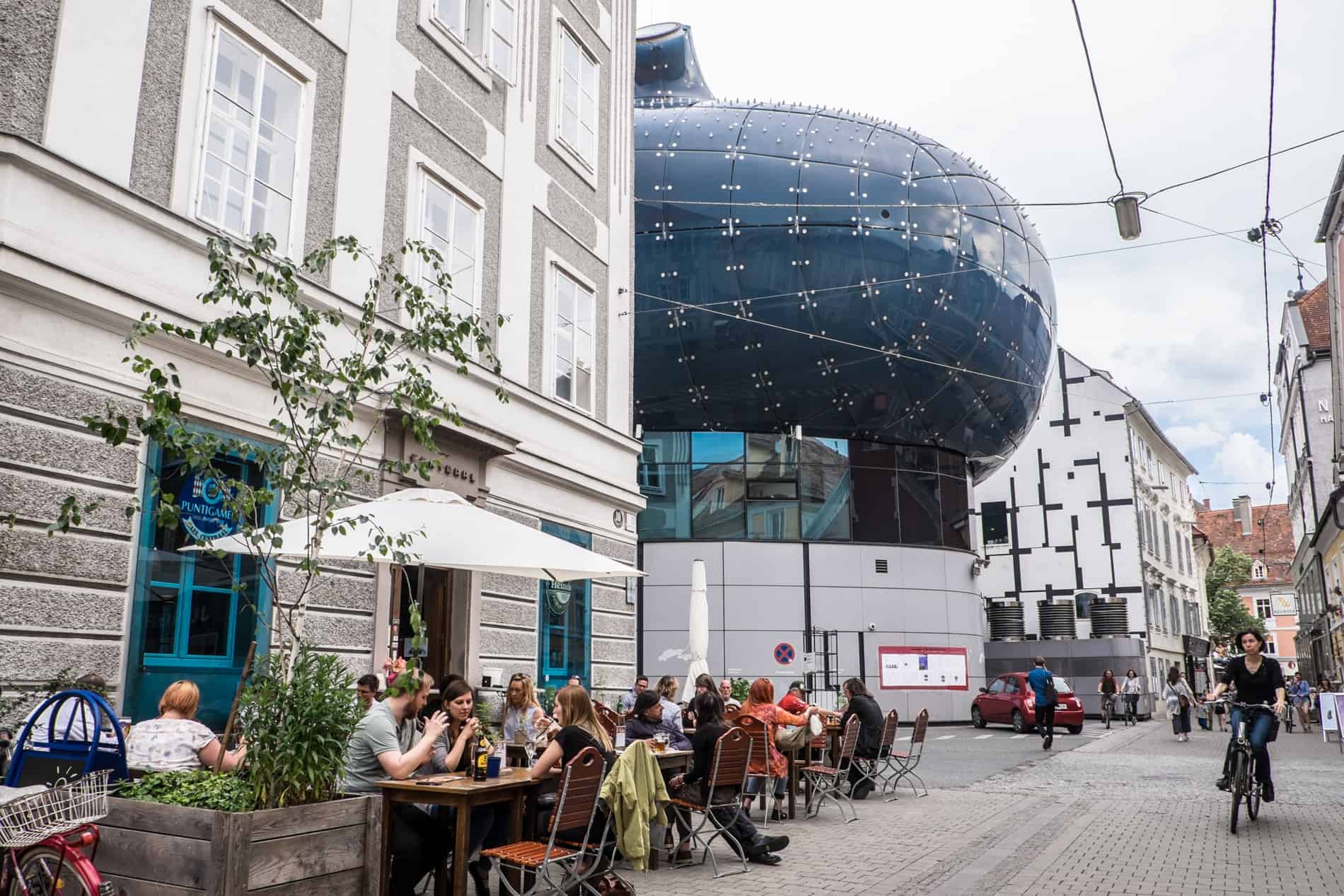
Life in Lend on the street behind the Kunsthaus modern art museum in Graz.
Design on the Mur River
The river itself, a vein of the old city, is connected with modern structures. The Murinsel is a café and exhibition space that sits in the water with footbridges that link to both sides of the bank, and the Mur Promenade, which you can access via stairs leading down from the main Erzherzog Johann Brücke, with a waterside bar and spot for relaxation.
The brave attempt river surfing in the strong currents, which you might be lucky to spot on a good day.
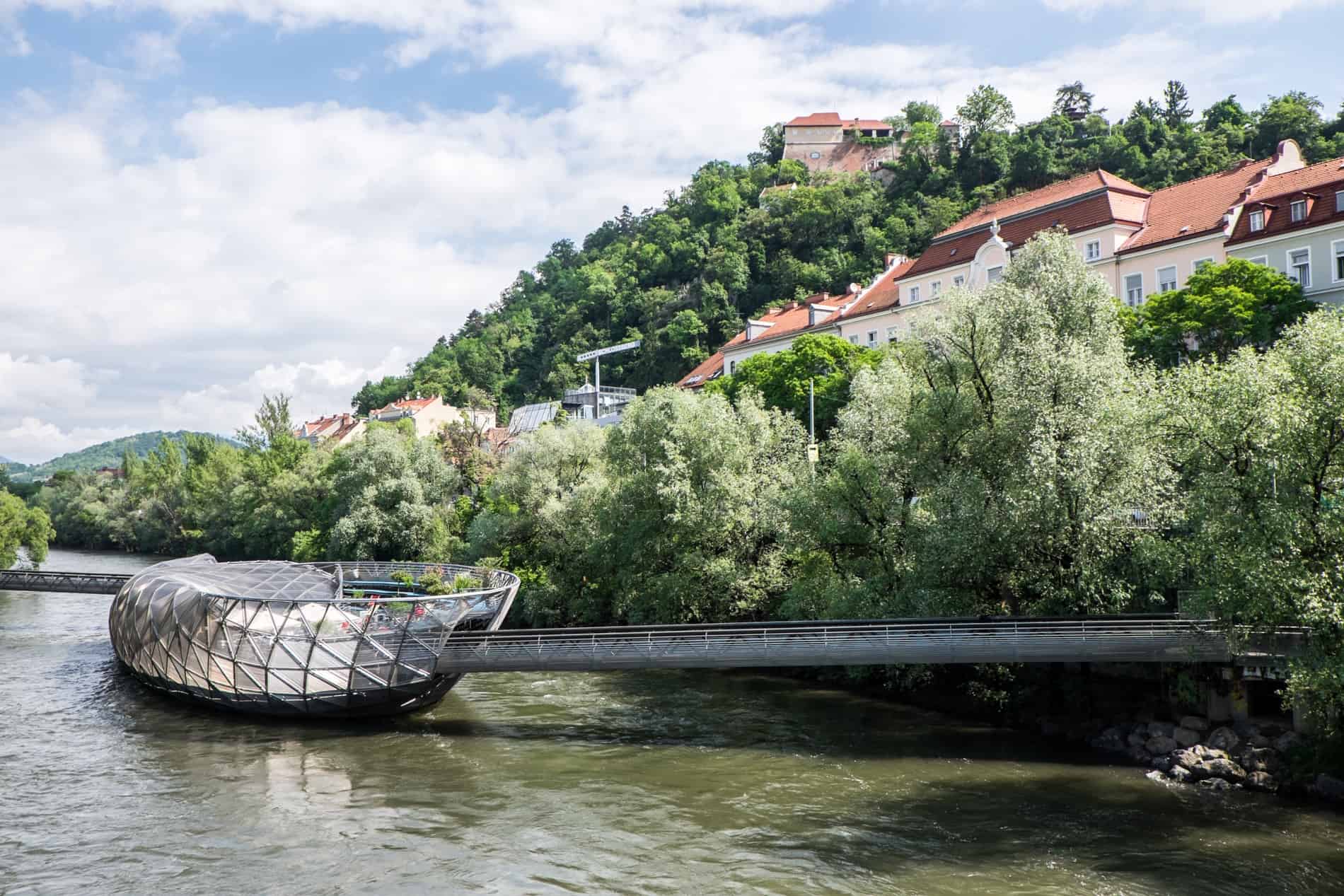
The Murinsel café and exhibition space sitting in the middle of the Mur River in Graz.
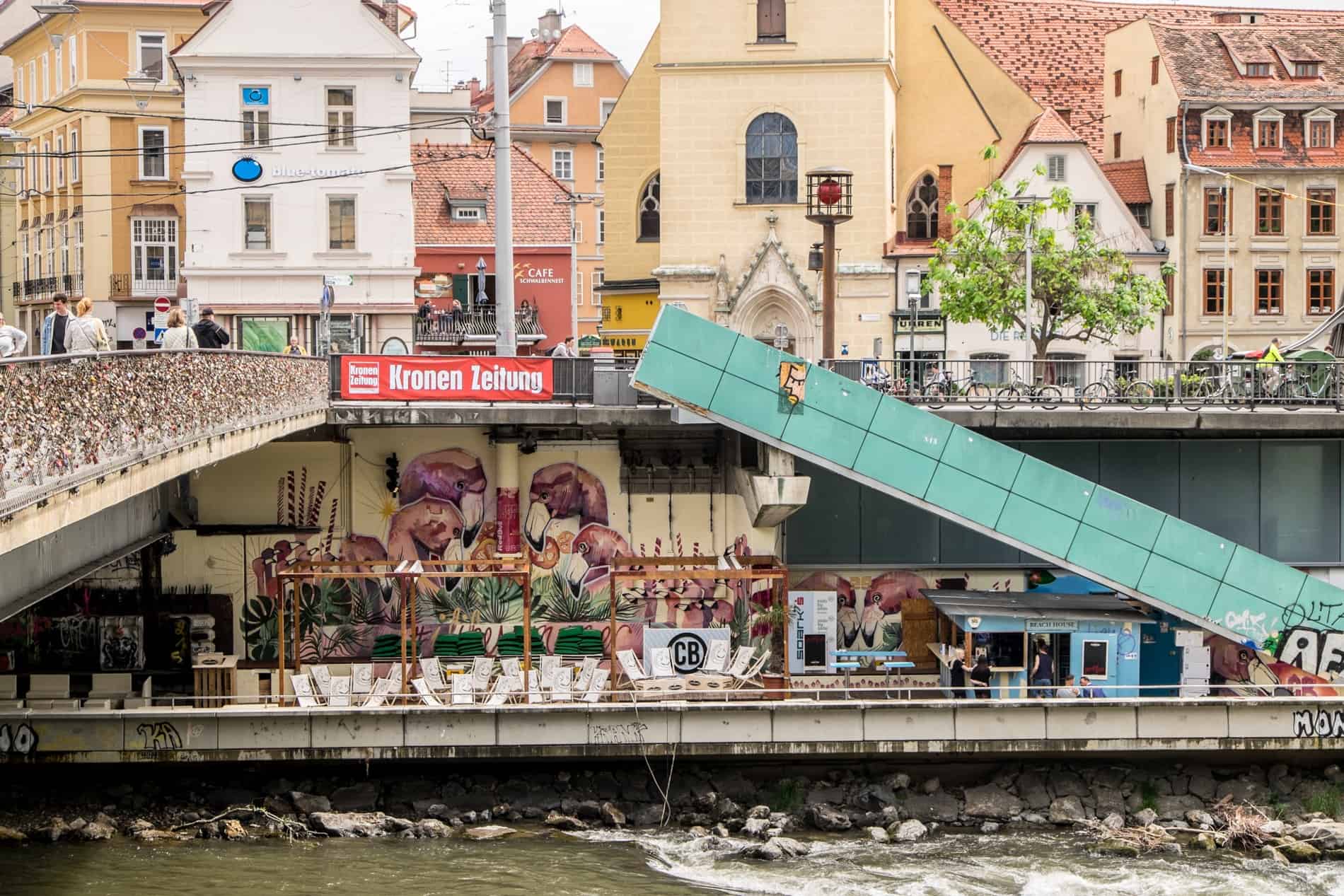
A bar under the bridge on the Mur River.
Creativity and Art in Graz Old Town
That’s not to say all of artistically urban Graz is contained solely on one side of the Mur. Artworks have made their way across the river, blending with the historic old streets in a homogenous mix of centuries-old and contemporary design.
Like the ARGOS building by Zara Hadid in Graz Centre, completed in 2020. These self-serviced apartment buildings replace an old “commodity house” building, and some dub its bulging eye-like structure as the ‘new friendly alien’.
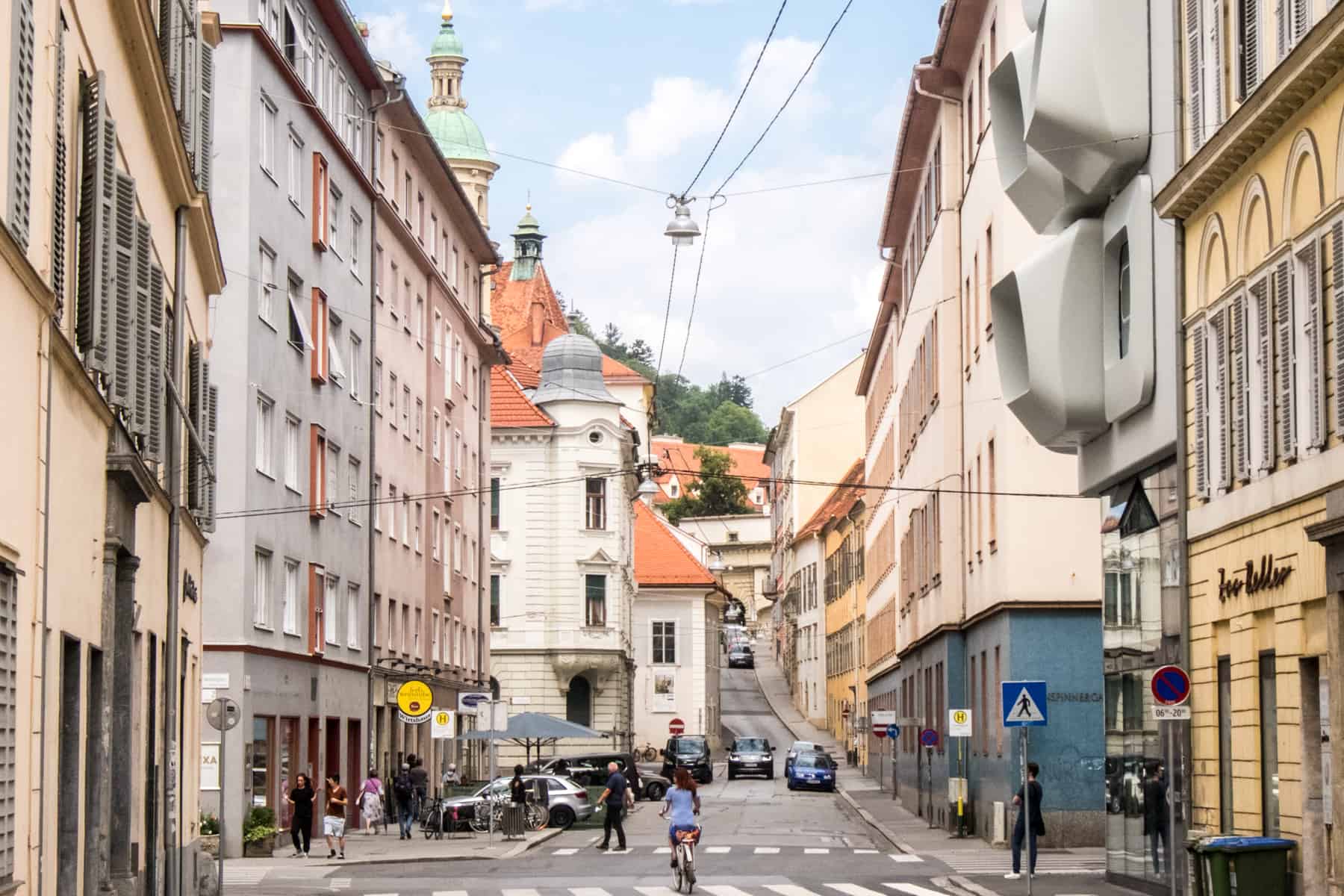
ARGOS building by Zara Hadid.
On one of my trips to Graz, there was a blue halo ring in Schlossbergplatz and a Red Bull racing car attached to the rocky Schlossberg wall. You’ll also come across sporadic structures on other squares, like the lampshade metalwork and the Joanneumsviertal Cultural Centre’s funky glass structure within old town streets.
The Parish Church on Herrengasse, while known for its Baroque Tower, includes a reminder to the cities darker days, featuring modern art stained glass windows, one which consists of a portrait of Hitler and Mussolini watching the crown of thorns coronation of Jesus.
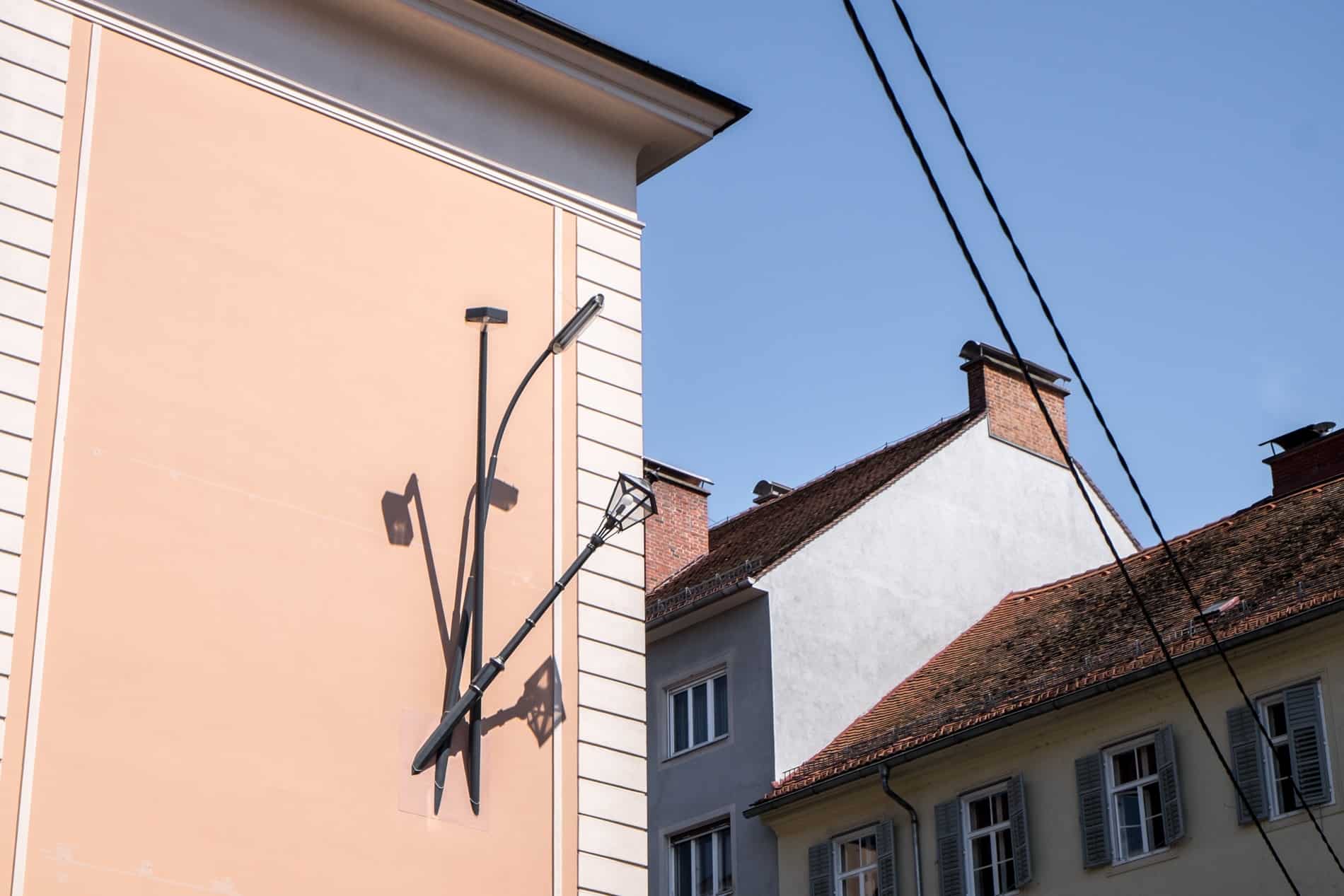
Public artwork in Graz Centre.
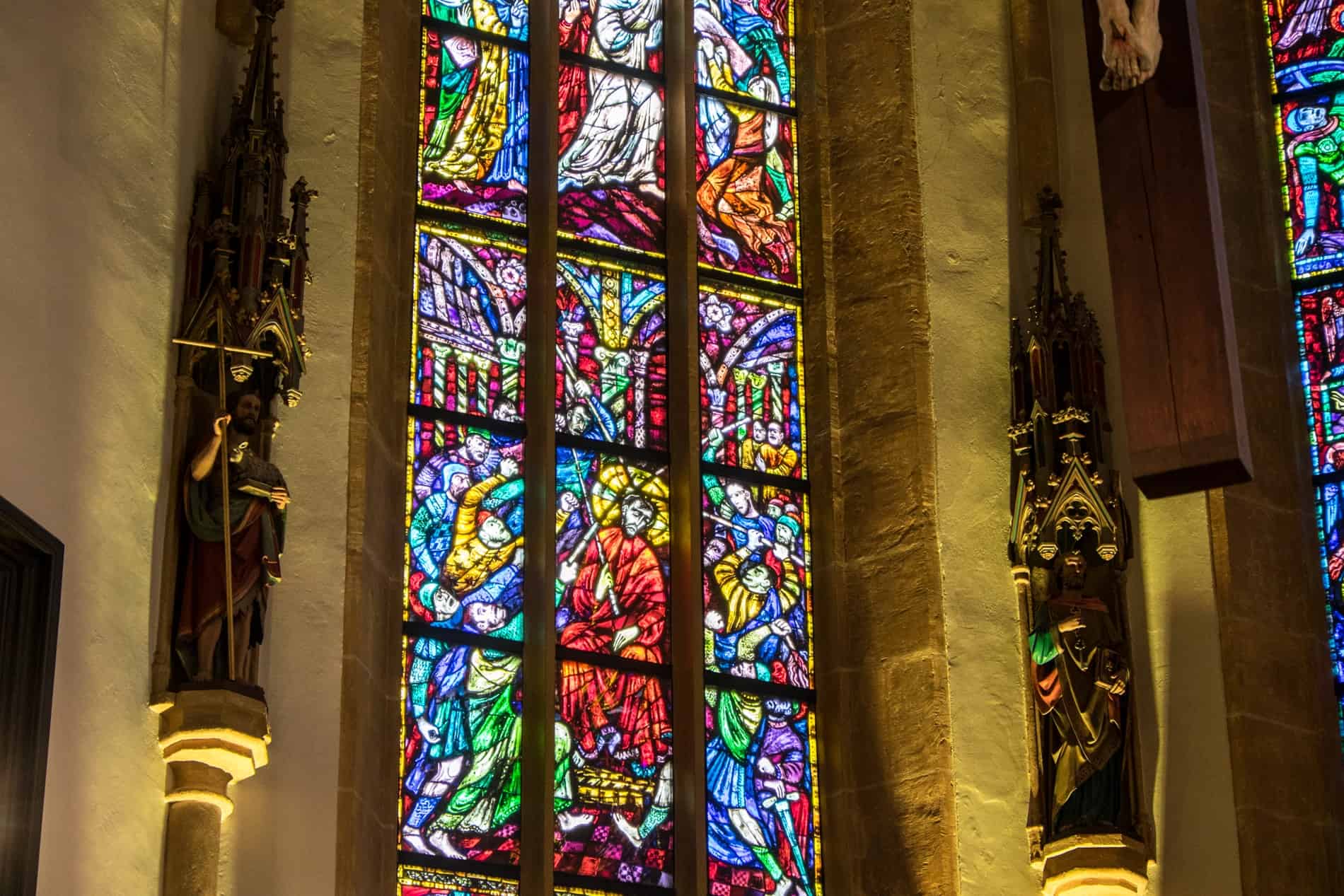
The Parish Church stained glass windows with some unlikely figures.
Graz also hosts plenty of cultural festivals throughout the year too, including the Austrian Film Festival in March, the electronic music Springfestival in May, and the Steirischer Herbst contemporary art festival in October takes over the city with everything from visual art, theatre and political debates.
Graz Trendy Eats and Hangouts
The hip Tribeka coffee shop is next to the Friendly Alien and where Graz’s younger generation hang out. Ducks Coffee Shop on Rabergasse is a central city favourite. For a taste of the Styrian craft beer scene, head to café bar Vintage. The city’s first package-free organic grocery store, Das Gramm sits next door to the old chocolate making shop.
Arnold Schwarzenegger fans can sip a coffee in a room dedicated to him in Andy Warhol style at the Grand Café Kaiserfeld. The ‘Governor’s Room’ is filled with portraits of the Hollywood star and Graz’s famous son. Nearby Thal is his homeplace where you can visit his birth house with is now a museum, where you can pose with a giant statue.
Local top picks for the Lend neighbourhood hangouts include brunch favourite Blendend, Rangoon for cocktails and Lotte (a smokers bar). We enjoyed taking random strolls and testing all manner of hideouts. For the best Backhendl indulgence (half Styrian chicken in crispy breadcrumbs) head to The Steirer, on Belgiergasse pictured below. The restaurant also has the largest selection of regional wines.
When the sun goes down, the old Graz hums with heavy metal and Indie music bars like Tick Tack and Guest Room, DJ spots like Café Mitte and underground clubs like Club Q.
Read More: Graz City Wine – The Revival of Urban Viniculture
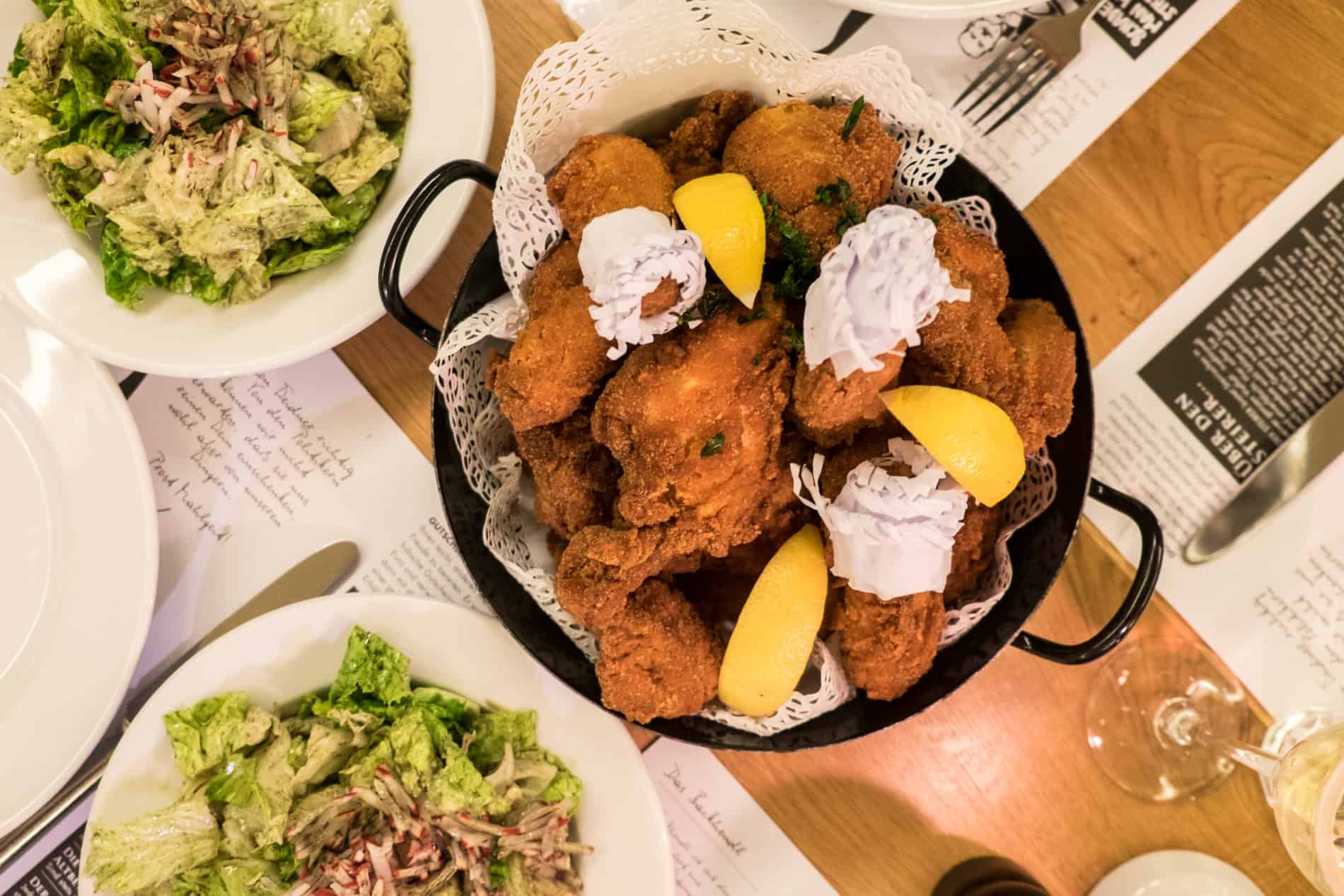
Backhendl salad served at The Steirer restaurant.
Extra Time for a Graz Day Trip?
Further along the Mur River, into the surrounding Steiermark countryside, upon a Styrian summit, exploring cultural monuments, and paying homage to the life of Arnie, there’s plenty of things to do in Graz within a 30-minute radius.
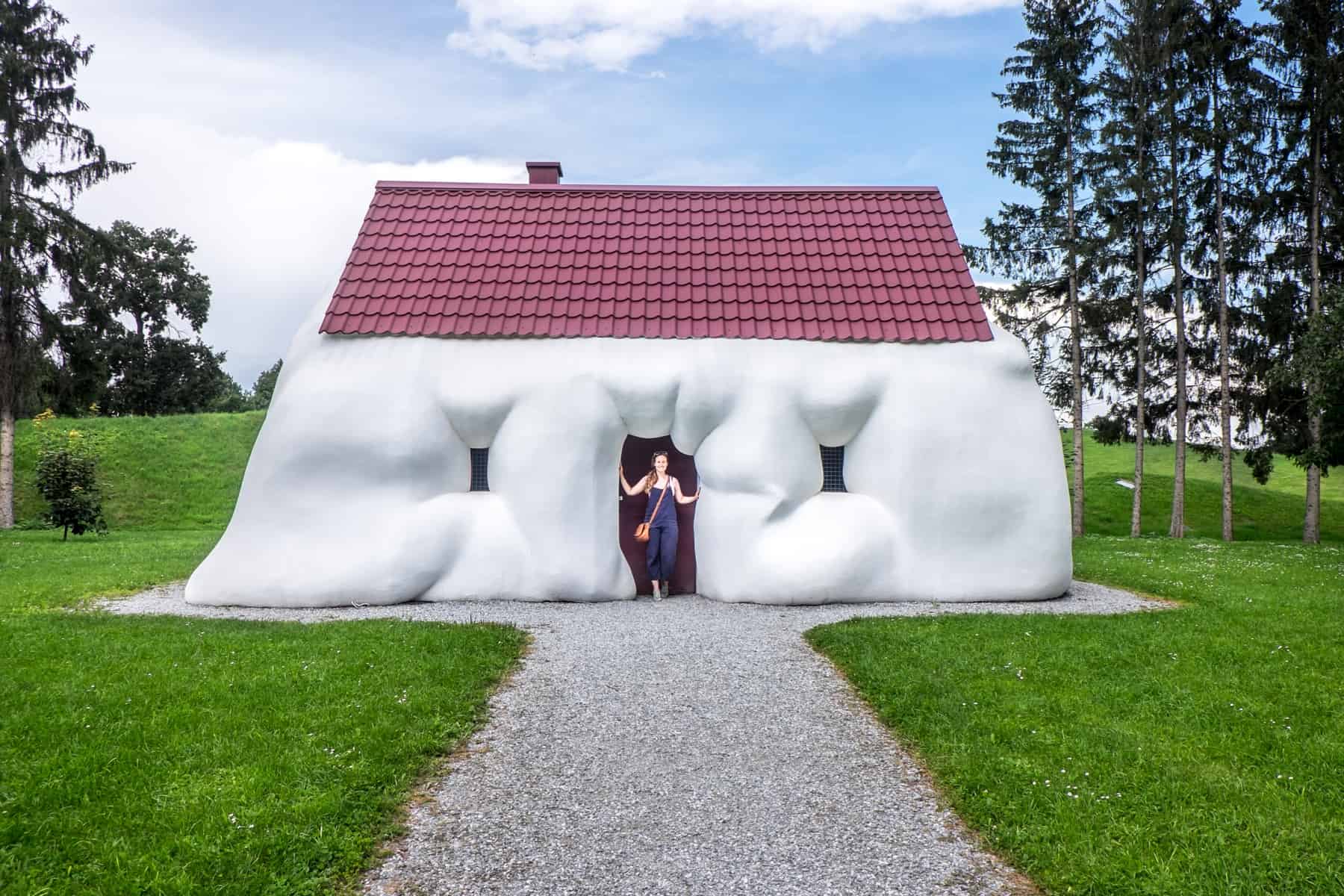
‘Fat House’ artwork at the Austrian Sculpture Park near Graz.
Travel Tips for When You Visit Graz
- Graz is close to Vienna and is well-connected to the capital (and all other major Austrian cities) via the ÖBB rail network. From Vienna, the train journey is approximately 2 hours and 30 minutes. Graz is also seen as a ‘sister city’ with Slovenia’s capital, Ljubljana, which has surprising similarities.
- Graz is an effortless city to explore on foot, which is why an all-encompassing city card isn’t necessarily needed.
- Grab a copy of the “Graz Made by locals for Young Travellers” map. It’s detailed without being boring, and full of insider hints and tips, alongside the very best hangouts, from coffee to quirky themed bars.
- Should you wish to take public transport, a 1-hour ticket (valid from the tram and bus) is €2.20 and a 24 hours ticket is €5, which is much better value.
- The ‘Altstadt Tram’ is a free tram that runs through the city centre, between Jakominiplatz and Hauptplatz, although walking is a better option to dig out all the small details.
- If you are a museum fan, the Joanneum 24 hours ticket grants admission to all exhibitions under the ‘Universalmusuem Joanneum’, which includes the Kunsthaus and Schloss Eggenberg (just outside of the city centre).
Where to Stay in Graz
The Wiesler Hotel
I’ve always stayed in the trendy part of Graz, first checking into the Wiesler Hotel on the other side of the River Mur from the historical old town. The lobby bears an artwork of jagged wood – a beam puzzle art installation by Austrian artist, Clemens Hollerer and is the first thing you will notice as you enter the reception, alongside the murals and design of the restaurant lounge.
Attention to artistic detail is what marks this hotel out on the ‘other side’ of the River Mur from the old town and is next to the ‘Friendly Alien’ Kunsthaus museum. It is a sister brand to the minimalist, smart Hotel Daniel. Rooms are light and focus on smart, minimal design, with some rooms overlooking the river.
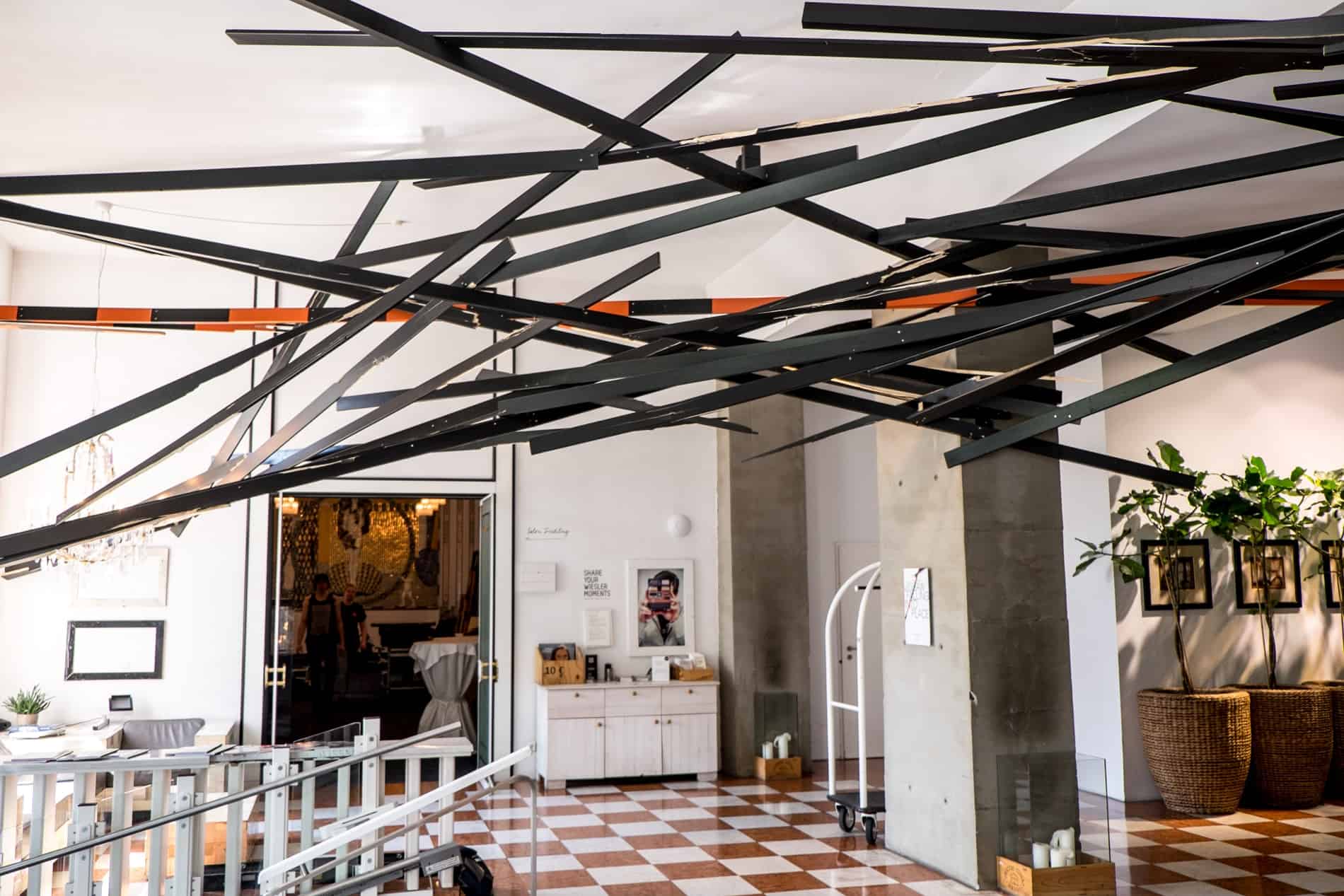
Art installation by Austrian artist, Clemens Hollerer at the Weisler Hotel in Graz.
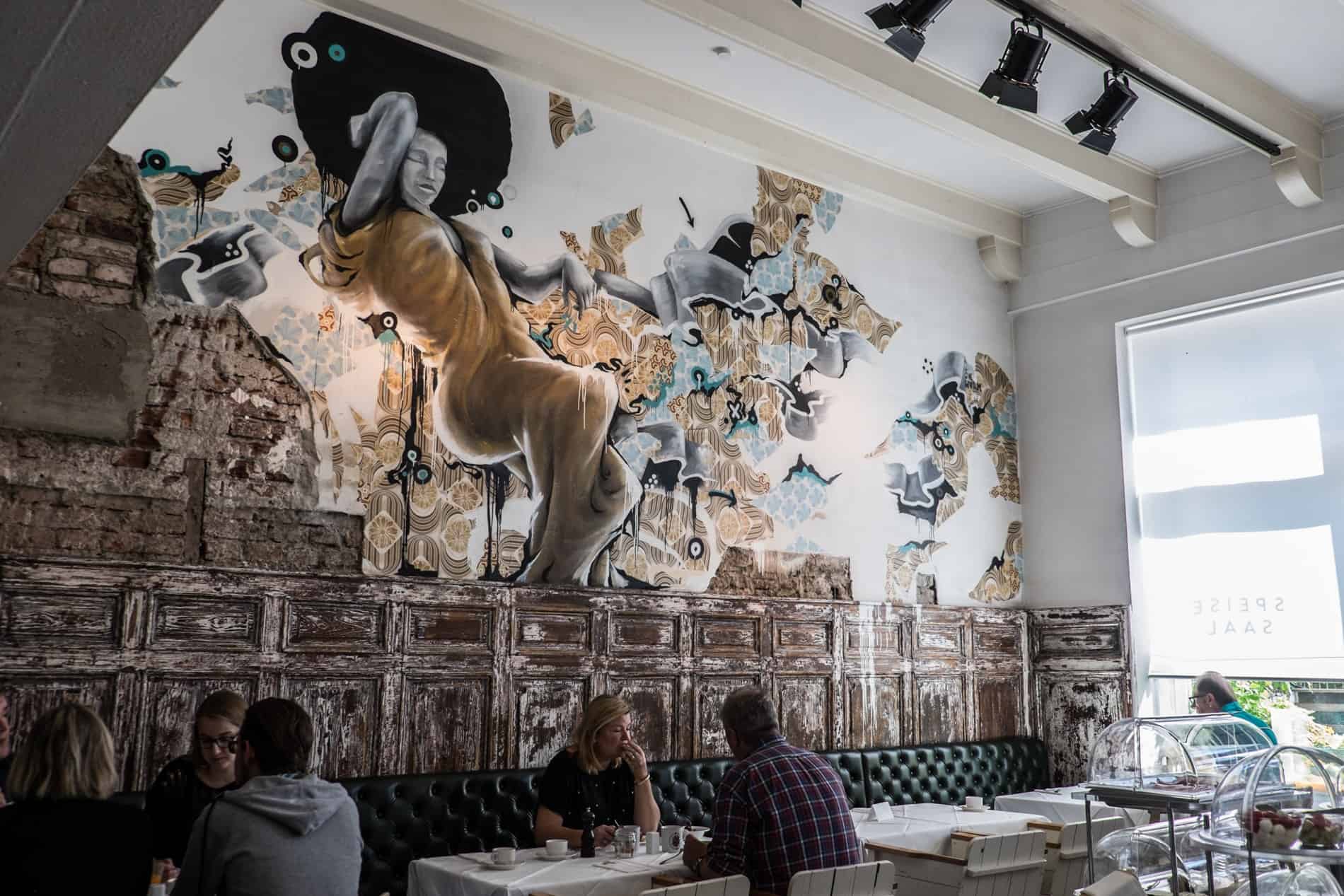
Restaurant inside the Weisler Hotel.
The Lend Hotel
More recently, I finally got to check out the Lend Hotel – a stylish art hotel that’s as hip as the neighbourhood, only minutes away from the main square. Rooms are smart and minimal, while every hallway wall has artworks from paintings to sculptures and furniture.
Breakfast is an extensive menu beyond standard buffet fare, and the lounge and restaurant area is a hangout in its own right rather than just an extension to the lobby. If you are staying there, head to the Lend Hotel rooftop for an alternative view of the fringes of the historical city centre.
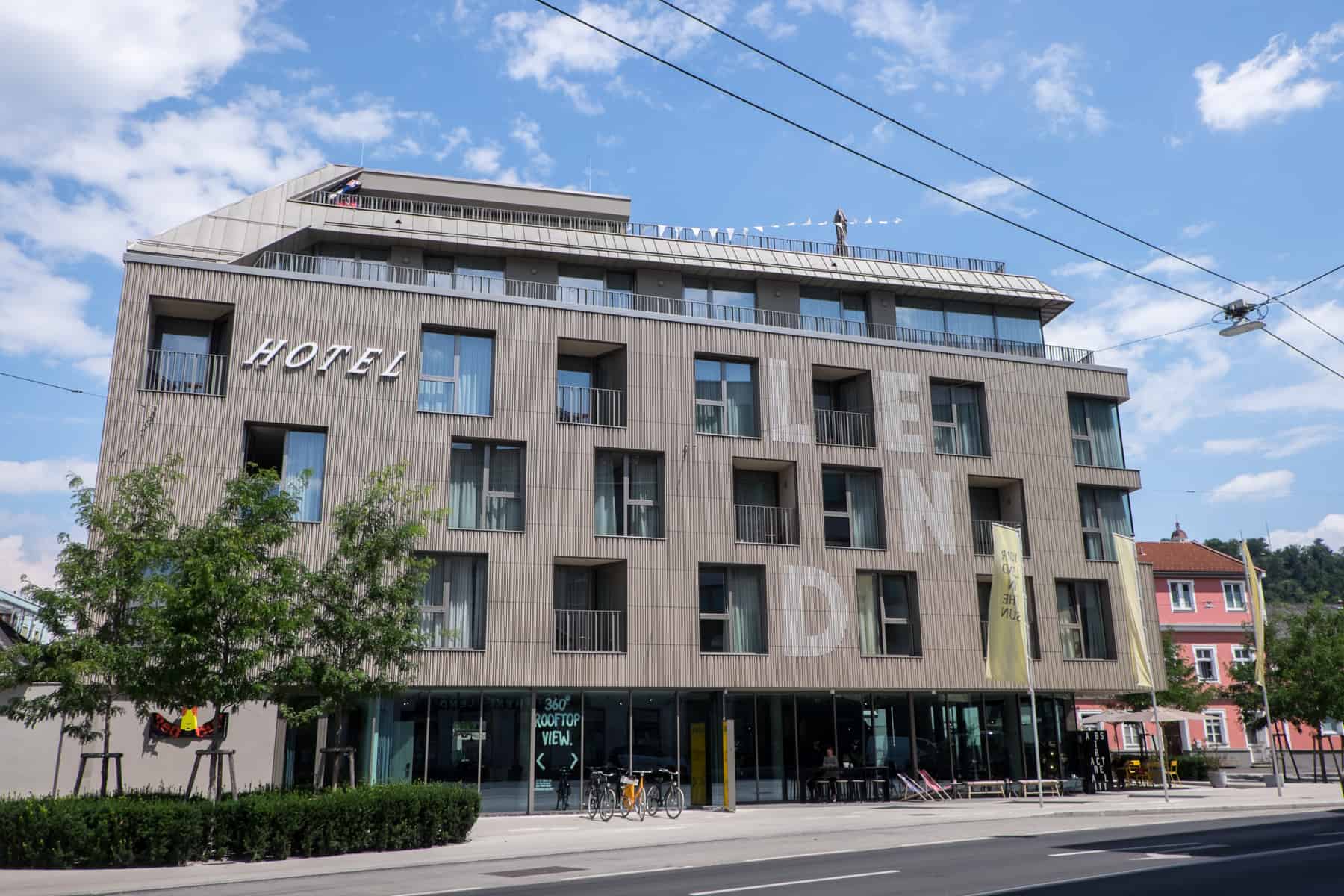
Arty Lend hotel in Graz.
The Parkhotel
I’ve also stayed at the family-run Parkhotel. A hyper-local 69-room hotel with a bar, spa and a fine-dining restaurant, Zur Goldenen Birn. It’s classically furnished with a homely lux feel, and there’s enough to keep you onsite, yet right in the heart of the student-led Geidorf neighbourhood filled with local enterprise.
Further Information on Graz
- The Graz Tourism Information website details further aspects of the city and its outer fringes.
- This guide to what to do in Graz was researched over four visits – a combination of personal trips and tourism projects to highlight the best of the city.

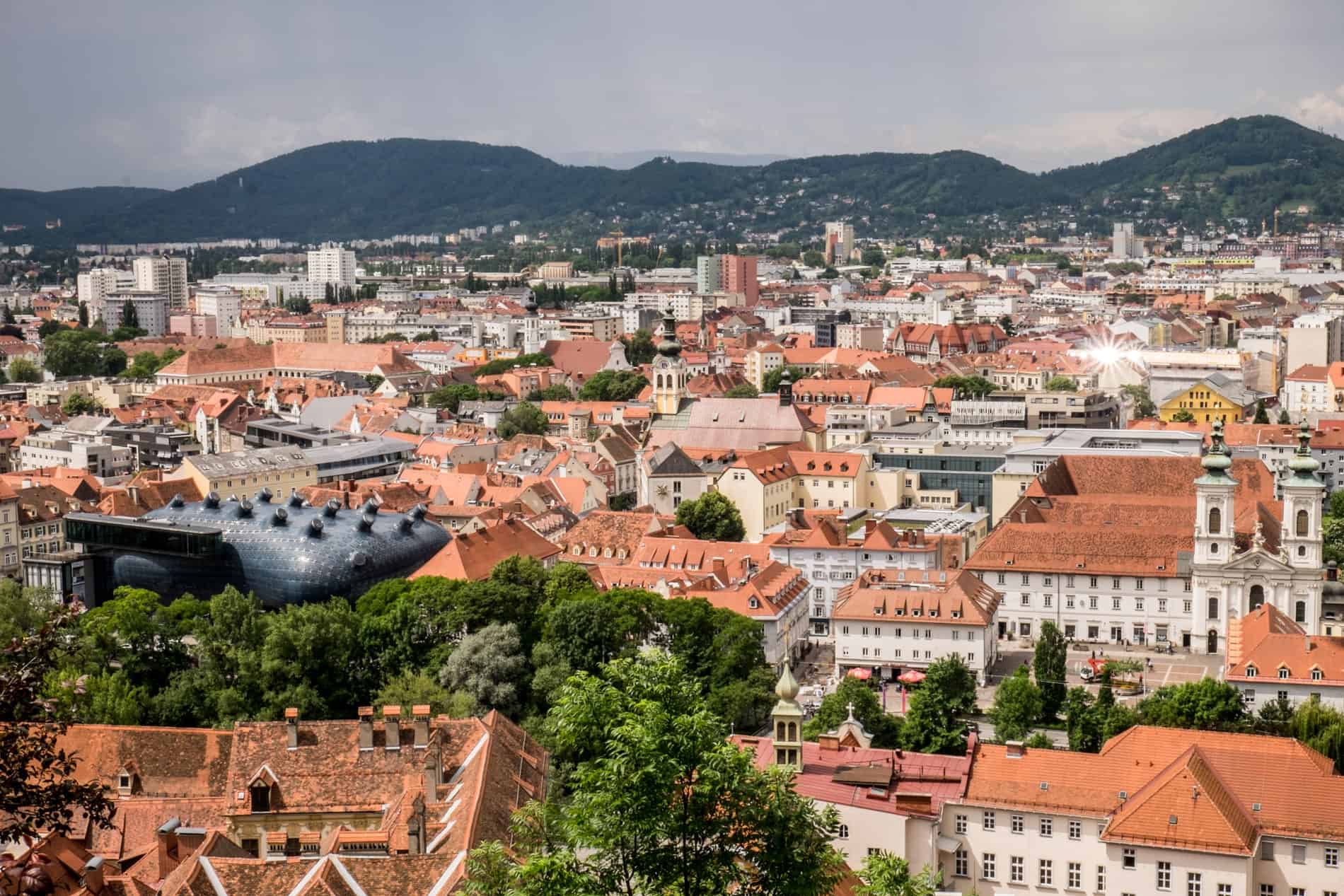
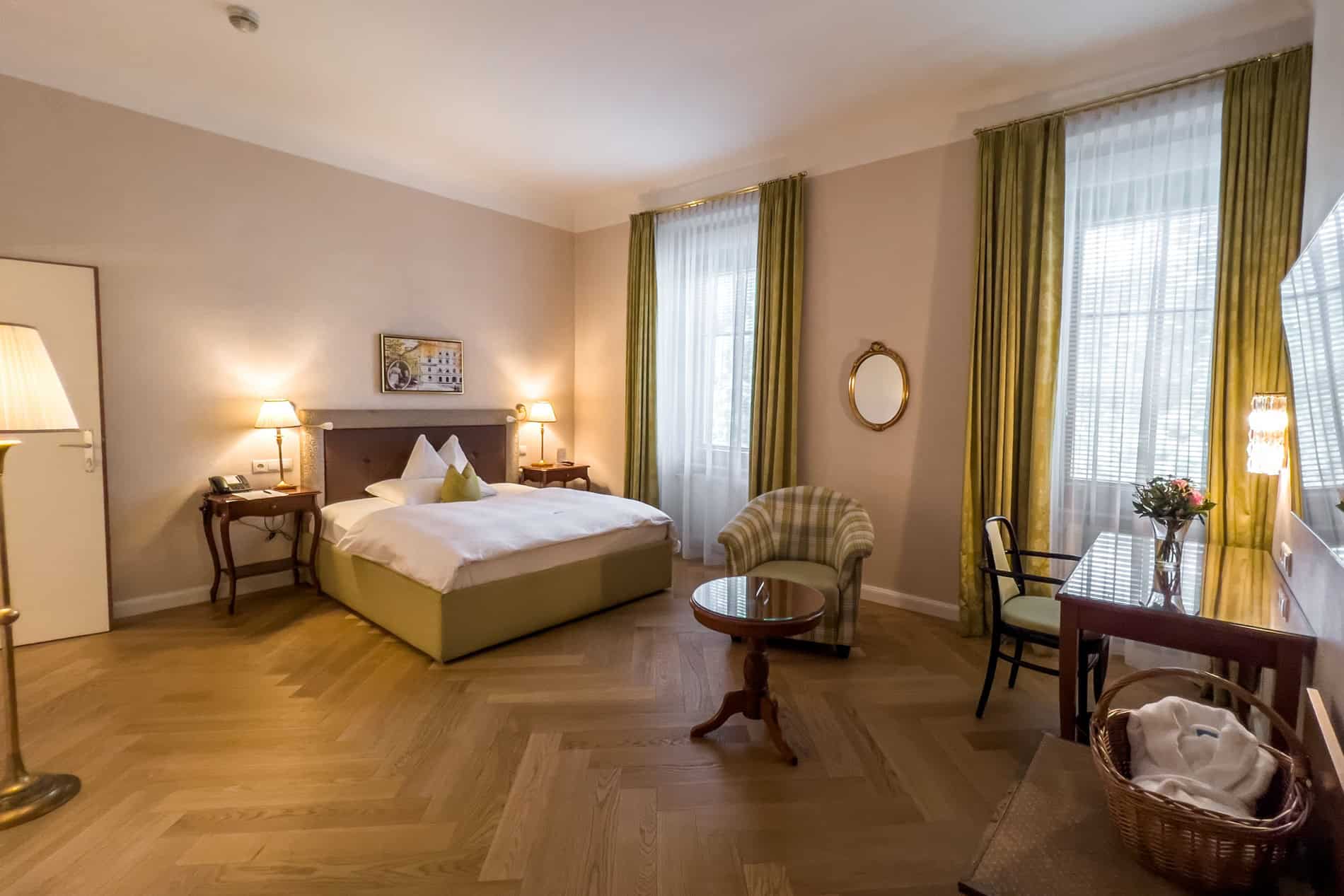
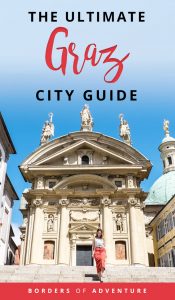

Hulya says
Thank you very much for your detailed information about Graz. I’ve been in Graz for 5 days and have one more week. Now i know what not to miss by your article. It helps a lot.
Hulya